.

MONDAY, DEC 28, 2020: NOTE TO FILE

Quora Q&A 4
More info offered
Eric Lee , A-SOCIATED PRESS
TOPICS: QUESTION EVERYTHING, FROM THE WIRES, TENATIVE ANWSERS
Abstract: So another fifty pretend answers offered. Few comments and no corrections offered, so I only learned from such research as I did for each answer. The number of views is of unknown meaning. The number of upvotes may be interpreted to mean at least that many peple read the answer.
COOS BAY (A-P) — So answers starting with 151 follow and may be of interest to someone someday. Answers are not mine. I reference some human sources. If the source, the data, is correct and the interpretation is valid, then Nature answers the question. As 'people would rater believe than know', answers that few or none Like or Share will be ignored, obfuscated, denied, and if necessary the messenger will be vilified, demonized, or killed. But 'my' answers are ignored, so I'm in no danger.
Questions:
151. If scientific innovation and advancement is not a benchmark for survival on earth then why human being is doing so at all cost?
152. With the world population at 7.839 Billion and already at a net gain of over 3.6 Million additional people day 16 into the new year [1/16/2021], is there really any excuse to have more than one child each?
153. Under which circumstance is rapid population growth beneficial to society?
154. What is Earth's human carrying capacity?
155. Will agricultural technology continue to develop quickly enough to support the rapidly increasing population?
156. What are some things that could happen when the human population reaches its carrying capacity?
157. Was Ted Kasczynski right about technology?
158. How much longer will Earth be habitable for humans? What is the maximum amount of people Earth will be able to hold? Will we have to kill off some of our population to survive in the future?
159. Is nature flawed since all if any non-intelligents species had their way they would destroy the entire ecosystem and themselves in the process?
160. Is it possible for society to collapse, and what would be the aftermath?
161. What if the Earth's population reaches 100 billion? Would food, water and mineral resources be capable of sustaining such large population? If not, what would it take to make it feasible and sustainable?
162. What is the origin and rationale of sustainable development goals?
163. Can we reconcile the need to intensify agricultural production system versus environmental sustainability?
164. What has the most potential to spark the downfall of our civilization?
165. After hundreds of thousands of years on Earth, what lesson do you think humans really should have learned by now but we still have not learned?
166. Is there any solution to mass fishing and farming with a constantly growing human population?
167. If the human population continued to grow at an exponential rate forever, what year would there be a trillion people on Earth?
168. Does our civilization have a future?
169. With technologic advancements in agriculture and consequently the increase in productivity, what's the maximum population the Earth can sustain before worldwide famine happens?
170. Who has the answers to humanity’s problems?
171. What is an essay about ecological literacy?
172. Should less populated countries invite people from more populated countries, so the world will be balanced?
173. Is global food security achievable?
174. What does the population density map look like?
175. If all potentially available arable land is used to grow crops to sustain human population, how many people can the Earth sustain given the current agriculture technology and the foreseeable future's technological developments in agriculture?
176. What do scientists estimate the carrying capacity of humans to be for the planet?
177. What would civilization look like if humans were naturally geared towards more long term thinking and living sustainably with the planet? Can humans ever evolve to be more like this? What type of temperament would this new sub species be like?
178. What are your insights about the ideas of sustainable development goals?
179. If you could save the planet by killing half the world's population, would you?
180. Can you please commit to a sustainable Earth and contribute?
181. Is global environmental sustainability achievable under capitalism?
182. What are the root causes of environmental problems?
183. Despite many scientists' warnings that global warming is becoming irreversible, when will it really become 'too late'? Has anyone quantified when the point of no return will be?
184. Without the restriction of the birth rate, is our planet threatened by an ecological catastrophe?
185. Will humans exist as a part of biodiversity within the limits of resources of the planet?
186. What is the most underrated civilization in history?
187. What is something that made you question reality?
188. With the speed of deforestation and world population, should we worry that in the next decade there will be no land animals living in the wild?
189. What is humanity’s biggest problem?
190. When will the human population exceed the carrying capacity of the planet and how much stress is the environment currently experiencing because of the continuing growth in the numbers of people?
191. The world population has been exponentially increasing at an incredible rate within the last century. Will humans be forced to deforest animals' natural habitats for agriculture and housing in the near future?
192. Should the U.N. or W.H.O. have a "hit list" of species, such as human or animal parasites, disease vectors, or disease-causing species, which should be driven into extinction? What species would you nominate for this list?
193. Many problems currently faced comes from the need to feed the growing population in an increasingly higher standard of living, instead of targeting supply, why not somehow lower the population so everyone can be supplied comfortably and sustainably?
194. Should the world adopt a single child policy for couples to allow the world to become sustainable again, given this would continue diversity as it was worldwide?
195. In the last two hundred years, the human population has grown much, much faster than at any other time in world history. What factors have led to this increase in the rate of growth?
196. If the global population is actually increasing by about 1.5 percent per year, and growth rate persists, then in less than half a century the number of people who live on the planet will double?
197. What is ecological literacy?
198. What is one major world problem, and how do you think we should solve it?
199. What is our goal as humanity for the next 1,000 years?
200. To save the planet should we all stop shopping?
Of perhaps more interest than the question is unpacking the assumptions/ideas embodied in it. Whether scientific innovation and advancement (e.g. H. erectus' invention of fire tech) contributes to our survival (that it contributes to economic/population growth is obvious), or that of other mammals whose biomass (96 percent or so) has recently been converted into humans, their livestock and pets (32-36% by weight are humans and 60-64% are livestock and other mutualists) leaving 4 percent to live as mere wild mammals in our Anthropocene, is questionable. Modern technoindustrial overcomplex society may be a benchmark of pathology more than survival. Earth's Biomass .
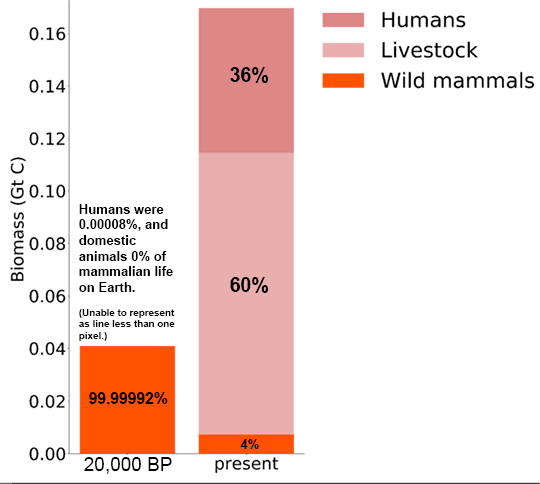
So why the full-speed-ahead-damn-all-the-inconvenient-evidence-to-keep-on-keeping-on-growing-the-BAU-economy-or-green-economy-stupid trajectory? Well, if we have to tell a story, might as well start at the beginning.
We are (descendants of) our ancestors going back to whatever the first self-replicating molecule was. Complexity can self-organize, complex systems can adapt and when they become 'living' it is because they have become complex, adaptive dissipative structures those complexity is such that as subsystems embedded within a vastly more complex system (e.g. Gaia), they become evolvable, and, well, you know, evolve.
Growth is good. Ask any ancestor. Extracting resources from the environment and converting them into your kind of biomass is to die for (and sometimes kill even one's own species for). We are clearly the supreme lifeform on the planet. For a time.
But we are such dominionists only because we have come to live as if we are not part of Gaia (Mother, Nature, the nature of things, the cosmos) and behave as if our short-term self interest in maximizing empower by consuming a planetary life-support system (aka Gaia, especially her larder of fossil fuels) is what will be selected for long-term. Expect Congress to repeal the 2nd and 4th laws of energetic systems soon (as if they could).
This is the same ideology (i.e. error, ignorance, illusion) as a cancer cell embraces in what looks like a body for the taking , a vast expanse of resources, an illimitable plane , within which to metastasize. The belief in growth possesses the cancer as the goodness of growth is self-evidently true because, for a time, it is what works. The joyful growth and prosperity of a metastatic cancer cannot be denied (apart, sometimes, from ample chemotherapy and/or radiation).
Nature loves maximizing empower, including a yeast in a vat of grape juice or a metastasic cell in your body. The only difference is that in the long-term, Nature selects against non-evolable, even if adaptive, dissipative structures, because if not selected for, they go away, dissipatively of course, e.g. the vat of grape juice (but the yeast sporulate). Nature loves a good whirlwind or tornado, even if they are not evolvable (the last whrilwind you saw looked pretty much the same as one a dinosaur saw). Life that fails to evolve goes away: Naturally.
The ability of a cell to exuberantly transgress all limits to its growth (for a time) is in its short-term self interest. But as its growth is at the expense of the body it was once a tiny subsystem within, the body system selects for containing it, and it always does. Sometimes the cancer can be contained, converted into a benign tumor that may not significantly impair its host. Or the host dies and thereby contains the enthusiastic growth of the adaptive, dissipative (but no longer evolving or evolable) structure within. A thunderstorm, with its flash of lightening in a summer cloud, is impressive. A cell in my father's body embraced Growth's Mandate, and in less than a month of exuberant metastasizing, the show was over.
So the answer is Nature loves MPP and maximum entropy production . Of course, unlike yeast or locust, humans have never adapted to overshoot and collapse, the pulsing unto overshoot paradigm. Maybe, if we can keep on repeating the pattern of building and collapsing empires long enough, we will evolve our empire building ways, like the Borg did. Or go extinct. Have a good Anthropocenee.
Oh, and to end with the obligatory positive note, there is silo science and systems science with its Thinking in Systems . I suppose it would not violate any laws of the universe if we Borg-in-the-making became Federation. 'In Wildness [the 4%] is the preservation of the world.'
152. With the world population at 7.839 Billion and already at a net gain of over 3.6 Million additional people day 16 into the new year [1/16/2021], is there really any excuse to have more than one child each?
It is entirely possible to graduate with highest honors from a top university and know essentially nothing about overshoot, carrying capacity, sustainability, or that there are limits to growth even if you are a STEM/STEAM/STREAM major. The more inconvenient truth is that most people would rather believe than know. Those who would rather know than believe, who question everything, who reevaluate all values and assumptions, who are abelievers, are some fraction of one percent. This is true for denizens of Facebook echo chambers and most think tanks to which only PhDs who have written at least several books are invited. Because the number of people who understand that we can't grow ourselves out of overshoot (the exact opposite being the case), e.g. via sustainable development, a Green New Deal, or more nuclear (plus fusion and Dyson Dots at L1...),, is so small and because they're just not listened to, it looks that overshoot will run its course as usual. Carrying Capacity, Overshoot and Sustainability
Our collective inability to think about the possibility that there are or ever could be ‘too many people’ on the planet has a long history that goes up to the time I am typing this. Ouora is one source of evidence. There are several questions on human ‘over’ population with over a hundred answers. Pick all of them and spend some hours scanning the answers and sorting them into sets of essentially the same answer. Do it as a citizen science project. Instead of watching another movie, updating Facebook, or going shopping..., do it.
Assume that most of those who answer questions on Quora think they know enough to have an opinion—not that they do, just think they do. So the data reflects the opinions of experts, whether academy vetted or not (as part of your study, note whether the answerer has a background in a field at all relevant to the question). Some people are more likely to know enough to have an opinion. For example, Richard Feynman is viewed pretty much by everyone who knows enough to do advanced physics as no ordinary genius. Feynman said, “Science is the belief in the ignorance of experts.”
Was he talking about self-accredited know nothing experts from the hood like me? No, he was talking about academy vetted experts like he worked with. My suggestion is that you listen to those who endeavor to listen to Nature who has all the answers. Then ask Nature questions and listen to the still small voice her data speaks. To be a bit more helpful, here’s a short, readable intro:
World scientists’ warning to humanity — Rex Weyler
Rex Weyler ends by noting: "As an ecologist, I feel compelled to ask myself: if the last 50 years of environmental action, research, warnings, meetings, legislation, regulation, and public awareness has proven insufficient, despite our victories, then what else do we need to do? That question, and an integrated, rigorous, serious answer, needs to be a central theme of the next decade of environmentalism."
The Fundamental Failure of Environmentalism — David Suzuki
On his 80th birthday, scientist and environmental activist extraordinaire David Suzuki noted that despite some victories of the David Suzuki Foundation and other efforts by environmentalists over the decades, that meanwhile "the pace of planetary destruction has not slowed ". Maybe there are no political solutions. Maybe any "integrated, rigorous, serious answer" will be wholly outside humanity's (including political activists to full-on eco-fascist revolutionary environmentalist's) current Overton window of thinkable discourse—for a time—yet know that things change, "this too, shall pass away", so learn now while access to viable information is still out there.
And always vet the source first (e.g. Weyler, Suzuki and who, if anyone, is publishing them, media bias/fact checkers are your friend and so is Wikipedia if you understand its limitations and bias). ALL UNVETTED SOURCES ARE NOT. Could a source know more than you do? Maybe. If so, maybe resist letting screens distract you and consider that:
WE WERE WARNED
(longer list here)
Harrison Brown, The Challenge of Man's Future 1954
Aldous Huxley, TV Interview 1958
Population, Evolution & Birth Control 1964, A Collage of Controversial Readings [from Han Fei to Garrett Hardin]
A Blueprint for Survival 1972
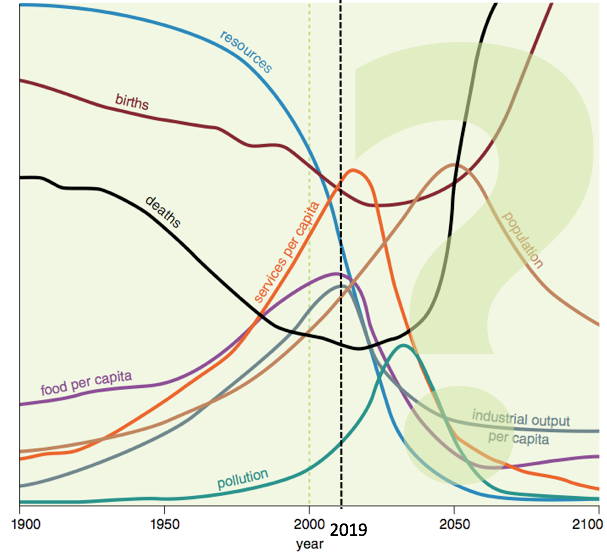
Overshoot: The Ecological Basis for Revolutionary Change 1980
A Planet for the Taking 1985
An Appeal for Joint Commitment in Science and Religion 1990
Elder Brothers' Warning 1990
World Scientists' Warning to Humanity 1992
Joint statement by fifty-eight of the world's scientific academies 1993
The Anthropocene: conceptual and historical perspectives 2011
Aluna: Elder Brothers' Second Warning 2012
Consensus Statement from Global Scientists 2013
World Scientists’ Warning to Humanity: A Second Notice 2017
Worsening Worldwide Land Degradation Now ‘Critical’ 2018
Living Planet Report of 59 global scientists & overview 2019
The State of the World's Biodiversity for Food and Agriculture 2019
Nature’s Dangerous Decline ‘Unprecedented’ (IPBES) 2019
World Scientists’ Warning of a Climate Emergency 2019
A Discussion and Call to Action on Global Catastrophic Risks 2020
(38 in roundtable, Part 1: Warning. Part 2 and 3: no 'real solutions' considered as consensus limits thinking.)
Wildlife in 'catastrophic decline' due to human destruction, scientists warn 2020
Limits to Growth Updated, Harvard & Yale 2020
Tim Garrett's Audio Warning 2020
International Scholars Warning on Societal Disruption and Collapse 2020
Underestimating the Challenges of Avoiding a Ghastly Future 2021
Freshwater fish in 'catastrophic' decline 2021 BBC summary
FINAL REPORT- Delivering the Human Future 2021 No real solutions
(The world needs a ‘survival revolution’ on a scale far larger than the ‘industrial revolution’)
Global Trends 2040 (2020 may look like the good old days) 2021
WORLD SCIENTISTS’ WARNINGS INTO ACTION, LOCAL TO GLOBAL 2021
(Now yelling and swinging the 2x4 against blindered heads harder)
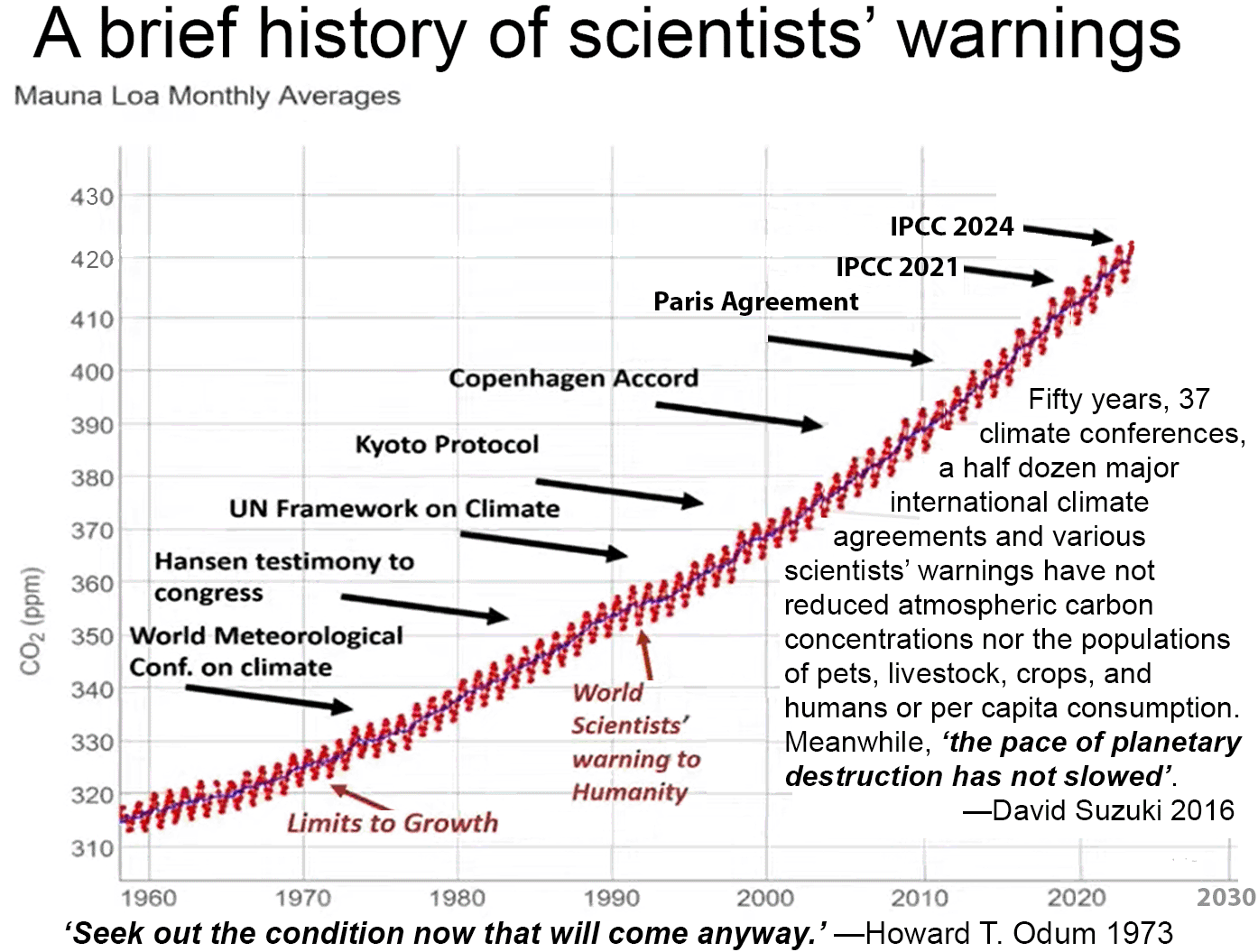
[Imagine that a world scientists' warning has a different outcome (maybe) than all prior ones. A month passes, a button is pressed and 20,736 world leaders (from top down) become unstuck in time. They have no distractions, no need to sleep, eat, breathe, have sex, or garner social approbation. For a timeless period they are intensively educated. Everything every world scientist has to teach is assimilated. The ether they inhabit is incompatible with error, and so all error associated with the warnings has been filtered out and as they now know everything that matters that every scientist had to teach, each leader far exceeds any of their individual teachers in understanding the human predicament. In the end all have triumphed over their inability to understand the implications of the exponential function. There is nothing more to learn about thermodynamics, the energetics of complex systems, carrying capacity, or overshoot. That humans are subsystems of Gaia from whom no decoupling is possible is as mother's milk to them. Thinking in systems has become child's play. In less than a heartbeat they find themselves back in their positions of power, privilege, and prestige as top government, business, media, NGO, military, university and religious leaders. All receive an invitation to join a Zoom meeting of 20,735 other leaders to discuss coming up with a plan of action to turn MTI (modern techno-industrial) society (that automatically thwarts all attempts to change its trajectory) into its opposite. The newly educated world leaders are 0.0001939% of the human population, but nearly 0.0004% of we adult hu-mans they serve or pretend to rule as leaders, i.e. 'mere puppets they, who come and go at bidding of vast formless things'.]
Update: Leaders did not grow the fossil-fueled modern techno-industrial socio-political economic system [MTI Empire], nor can they degrow it. Of the 20,736 leaders, some acted on their understanding and were rapidly selected out of the system. Others, in all knowingness, go with the humancentric flow to nudge it as best they can and thrive. After retirement, they attend Club of Rome meetings. There are no political solutions.
"In order to change an existing paradigm you do not struggle to try and change the problematic model. You create a new model and make the old one obsolete. That, in essence, is the higher service to which we are all being called." —R. Buckminster Fuller
In an alternate time line,the leaders are randomly divided into 1,728 groups of 12. Each group spends six months getting to know each other and discussing the human problematique (while adding to their understanding of it). Each group then selects a leader who can be replaced at any time by consensus of the eleven. The 1,728 leaders are randomly divided into groups of 12 who take a year to get to know each other and discuss issues. They agree upon who represents them. The 144 second cut leaders repeat the process. In a year there are 12 leaders able to make rapid emergency decisions. Of the 12 on the High Counsel, one would serve, for some hours as the supreme leader of the sapientocracy, to make decisions in extreme emergencies before the other 11 could consider the issue, whose decision would strand until the 144 could consider the issue and so on to the 20,736 representatives of each Watershed Management Unit of Earth. Only those who demonstrable knew enough (about the limits of their knowledge) to have an opinion would serve, for a time, to offer their best posterity and biosphere serving guess.
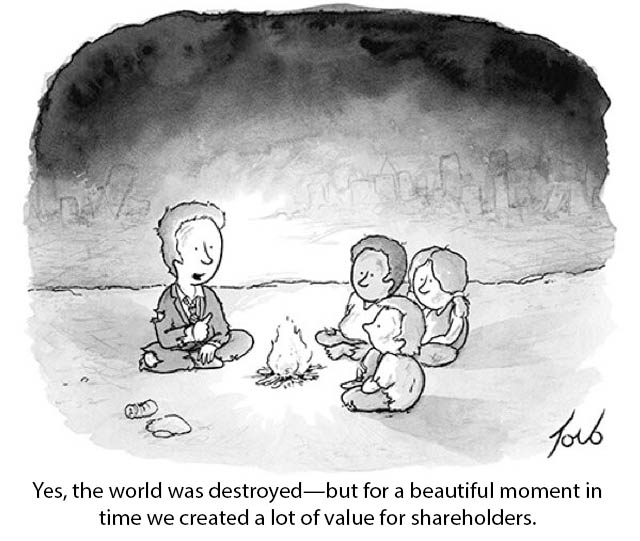
Capitalism was insanely great at growing the economy. And then what?
Note:
I've started to answer most questions that seem to be asking for information with the same answer. So I will not include anymore of the sort. Intro paragraphs will vary, but about the only reason to answer questions on Quora is to offer links to information that could matter to anyone (e.g. a young human) willing and able to follow the breadcrumbs of evidence
153. Under which circumstance is rapid population growth beneficial to society?
When the environment is unpopulated or underpopulated, rapid population growth is possible and for a time appears beneficial. When guns, gems, and steel cam the the Americas, most of the human population died from diseases that preceded the Indo-Europeans, and guns and steel killed others. The increase in population in the Americas, since, or globally over the last 12k years, appears beneficial for a time, just as the rapid increase in the reindeer population on St. Matthew Island did to the reindeer up to the seventh doubling in their population.
They were introduced during WWII to provide emergency food for those manning a remote radar site incase their food ran out and they couldn’t be resupplied. They didn’t run out of food and no reindeer were killed. In the late 1960s the last reindeer died. Was their rapid population growth beneficial?
Environmentalism without Environmentalists
154. What is Earth's human carrying capacity?
Carrying capacity : the population of a given species that can be supported indefinitely in a defined habitat without permanently damaging the ecosystem upon which it is dependent; the number of people, other living organisms, or crops that a region can support without environmental degradation.
When a species exceeds carrying capacity it causes permanent damage to the biome it depends on, whether a small watershed area or planet Earth. When a species' footprint causes the extinction of other species, that impact is permanent and causes environmental degradation. So one measure of ‘degradation’ is 'causing species extinction' which is objectively measurable. We are currently presiding over the greatest mass extinction event since the late Cretaceous, one that may rival the Permian, and so we have exceeded Earth’s carrying capacity for humans which began when we became a technology-using invasive species spreading beyond the African savannas that we evolved in. The rate of anthropogenic species extinction is now over 100 times baseline, heading towards 1,000 times faster by the end of this century.
Ecological overcarry limit: the number of people, other living organisms, or crops that a region can support without environmental degradation caused by a plague phase overpopulation of the species causing the degradation, an overshoot that goes too far, resulting in its depopulation (e.g. locust, modern techno-industrial humans); the population level associated with overpulsing.
With no predators on St. Matthew Island, the introduced reindeer were able to blow past the long-term sustainable maximum population the island could support, assuming all primary productivity goes to supporting reindeer, when their population exceeded about 1,200, or the overcarry limit of the island. Their population continued to grow until it reached about 6,000. And then what?
Ecological overshoot: occurs when a population's demand on an ecosystem exceeds the capacity of that ecosystem to regenerate the resources it consumes and absorb its wastes; pulsing paradigm norm within long-term limits not involving a plague phase and not associated with causing species extinction. Nature's Pulsing Paradigm .
Our species lived for 300-500 thousand years on the African savanna with regional populations pulsing under the carrying capacity of the environment, rarely, and only briefly, exceeding carrying capacity before negative feedbacks (conflict over scarce resources, starvation) lowered the population. Overshoot causing the extinction of other species is an extreme measure of overshoot. Global population of humans was less than a million. From the POV of our ancestors before agriculture and empire building began, after humans spread out of Africa and numbered about 5 million, we technoindustrial humans, living mostly in cities, are short-termers living the pathogenic life of an invasive species prior to correction. A maximum human population that would not cause species extinction (assuming humans live as agents of the Earth and work to restore Nature or prevent the evolution of new species to replace those already driven to extinction) may be as high as 35 million.
Overpulsing paradigm: pulsing above overcarry, commonly associated with invasive species lacking control feedbacks, resulting in one-off overshoot population growth followed by population descent/collapse; e.g. reindeer on St. Matthew Island, modern techno-industrial humans.
A pulsing population and carrying capacity is the norm. Conditions that allow overpulsing unto overshoot followed by a mass die-off is not, with few exceptions such as yeast who have adapted by being able to sporulate, or locusts who undergo morphological and behavioral changes that select for some to survive and transition back to a pulsing paradigm norm for some years until favorable conditions again allow plague-phase swarming. Humans have no adaptation to overpulsing. If 500 million humans could be supported on planet Earth without turning fossil fuel into food, then we overpulsed our population about 370 years ago. Because of fossil fuel inputs, corrective feedbacks have yet to make corrections. As humans have no prior experience with global collapse (just regional for the last 11k years), no literate humans may survive our descent phase.
If the maximum sustainable number of reindeer St. Matthew Island could support was 1,200 and the 29 reindeer introduced in 1944 exceeded this number in 1957, then they would have continued to degrade the stored primary productivity in the form of lichens and grasses of the island. If when the population had reached 800, the vole population collapsed and with it the fox population, then environmental degradation would have occurred. If there had been wolves on the island and the reindeer population had leveled off to pulse between 400 and 500 over the centuries, then the carrying capacity for reindeer would not have been exceeded. Voles, foxes, reindeer and wolves would be able to continue living on the island, though the vole and fox populations would be smaller.
Carrying Capacity and Overshoot
155. Will agricultural technology continue to develop quickly enough to support the rapidly increasing population?
I was trained to be an agronomist with degrees in soil and crop science, but turning fossil fuel into food is not sustainable. The answer is no, because technology is not the cause of our ability to industrially grow food, nor was the Industrial Revolution powered by technology and clever apes.
Technology and clever ape invention is a precondition for 300 years of economic growth, and the Green Revolution innovations were a precondition for turning fossil fuels into food on the scale we are now, FOR A TIME.
But THE precondition is energy, mainly (85%) fossil fuel. About 90% of the food that travels on average 1,500 miles to get to the end of your fork is made of fossil fuel inputs, without which there will be a food longage of demand. With ever increasing EROI, fossil fuel use will peak (conventional oil peaked 2018) and decline, and with it food production.
No matter how fast you print money, all the truly clever apes on the planet locked in a big room until they solve all shortage problems won’t. Unlike most people, they will die in their room. Sorry about that. I told you, but who cares?
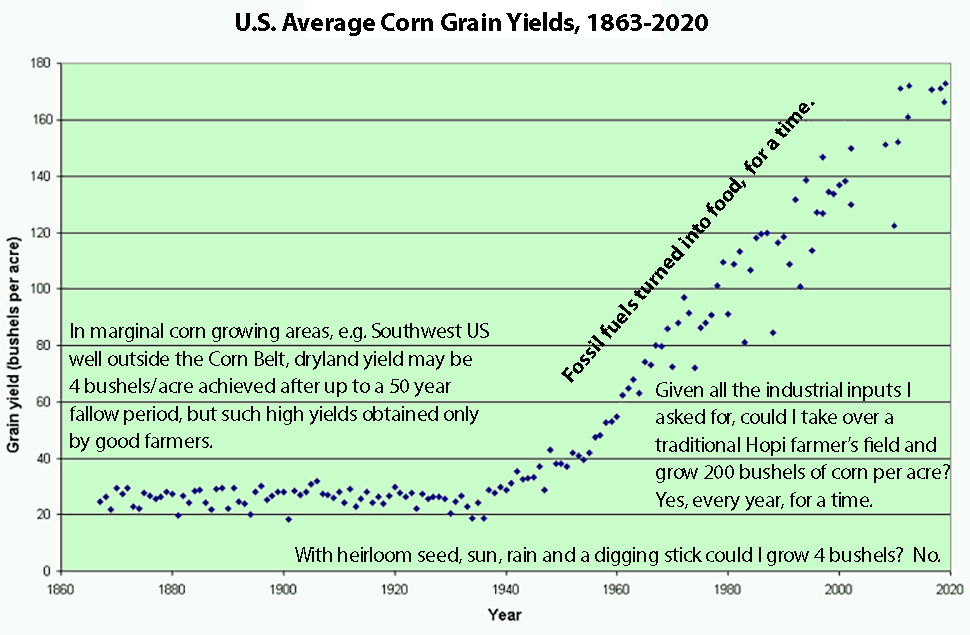
156. What are some things that could happen when the human population reaches its carrying capacity?
Politically speaking, it is incorrect to think we have exceeded carrying capacity or may do so in the future, hence the concepts of 'carrying capacity' or 'overpopulation' are meaningless when applied to humans. Many religious ideologues/pundits agree, but all right thinking humans agree that humans are exceptional, that so-called laws of nature do not apply to them.
But to scientists who endeavor to listen to Nature, she speaks a different, a various language. Anyone who doesn’t care what the still small voice of Nature says, can stop reading. Otherwise consider:
Carrying Capacity and Overshoot and Population x Consumption
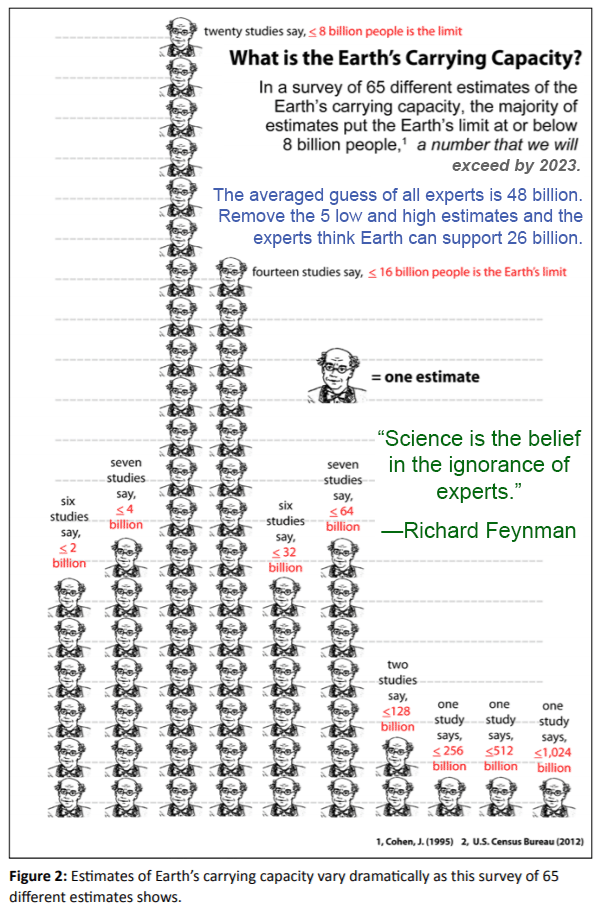
Cited by authoritative BBC article in 2016.
157. Was Ted Kasczynski right about technology?
I have read both his books, and you can too: Technological Slavery (2008), and Anti-Tech Revolution (2016).
I rewrote one of his stories, Cruise Ship of Fools , and wrote to inform him and send a copy as he has no computer or would use it if he did. He wrote back to suggest I read his second book, which I did.
Basically, his intuition that technology ultimately does more harm to the one using it (and nature) is correct. We use it to deforest vast areas for short-term self-benefit, but in the long-run we destroy the life-support system we depend on and in fact are. Technology enables us to live, for a time, in complex societies that over an 8–12 generation period, transforms us into dysfunctional ‘humans of NIMH’. Critical Mass Transcript
Without technology we would not be using fossil fuel energy to grow our population x consumption to over 8 billion, for a time. Population x Consumption
We do not yet, if we ever can, control technology. It controls us. Do you have a ‘smart’phone? We have technology but we are also had by it.
Where I diverge from Ted is on what might be called ‘real’ solutions, ones that might actually work. He only conceived of political revolution and believes in political solutions like everyone else. I assume there are no political solutions, given the last 10k years or so of human history. More of the same will not work. Ted is not revolutionary enough even if his intuition was better than most. We of modern techno-industrial society have met the enemy….
158. How much longer will Earth be habitable for humans? What is the maximum amount of people Earth will be able to hold? Will we have to kill off some of our population to survive in the future?
In about 600 million years photosynthesis may not be supported and all animals, from zooplankton on up that depend on phytoplankton on up to trees will not be supported. Future of Earth - Wikipedia
A maximum number of humans will be a peak climax population that is not remotely sustainable. I know one ecologist who asked over thirty other experts who maybe know enough to guess what the maximum sustainable population might be, and the range was 50 million to 2 billion, averaging about 1 billion. A maximum population is not an optimal long-term population as assumed is that all primary productivity of Earth’s lands and seas go to support humans and their livestock, crops, and pets with maybe a few plants kept in botanical gardens and animals in zoos for human recreational use.
If humans were to live on Earth without causing species extinction or preventing new species evolving to replace those we have and increasing will cause to go extinct, then the human population would be in the 7–35 million range. Carrying Capacity and Overshoot
We won’t kill off each other to lower the population. We will do so by fighting over scarce resources by conflict as usual. If we do not, then starvation will depopulate the planet of humans as usual. List of famines - Wikipedia
To avoid a die-off, we could manage a rapid birth-off, but doing so is politically impossible for political animals. If some humans cease to believe in political solutions, then they could embrace a managed descent by voting with their feet to create an ecological civilization to replace the current business as usual one when it collapses. Design for a Viable Civilization
159. Is nature flawed since all if any non-intelligents species had their way they would destroy the entire ecosystem and themselves in the process?
Rescale the question from an entire ecosystem of species to an entire vertebrate body of cells. Both are complex auto-organizing, dissipative natural systems that are adaptive and evolvable. Is your body flawed since if any cell had its way, went ‘wild’ to reproduce to maximize it’s short-term self interest (by turning malignant and consuming surrounding tissue), it would destroy the entire body and itself in the process?
All bodies have the potential to be destroyed by wild cells, but this is selected against, i.e. corrected, which is not a flaw in Nature, the system. The pathologies of complex systems are the flaws that Nature corrects. Modern techno-industrial humans are unlikely to destroy all life on Earth the way a metastasizing cancer may destroy one organism.
Nature will select against a pathology. If humans were intelligent, or were to become so, they would foresee the outcome and limit their growth (population x consumption) as all normal cells do to live in harmony with the natural system they depend on to persist within. Carrying Capacity and Overshoot: The objective view.
160. Is it possible for society to collapse, and what would be the aftermath?
For hundreds of thousands of years humans lived in band-size societies (typically 20–50 related people) and while groups may fail to survive, hunter-gatherer societies did not societally collapse. When settlements, mostly enabled by agriculture, were able to support populations greater than Dunbar’s number (about 150), on up to thousands, tens of thousands, to hundreds of thousands, then collapse became the norm.
Unsustainable complex societies arose and fell. All prior ones collapsed, declined, or ‘faded away’ depending on your sense of time. All that survived into modern times were subsumed by modern techno-industrial society in the form of a now global empire. The belief that it will not collapse is, well, belief-based. The aftermath will be as usual, so consider recent history, especially the last seven thousand years. Consider the Past Lives of Humans.
The Indus Valley Civilization had an aftermath.There has never been a global complex society before and the outcome of its collapse is unknown. A remnant population may survive, but virtually all information may be lost along with all literate humans.
Dancing around a pink boat isn’t enough. Consider a full on “‘survival revolution’ on a scale far larger than the ‘industrial revolution’” See FINAL REPORT- Delivering the Human Future Conference: A report to the Governments and Citizens of Planet Earth- Executive Summary March 2021
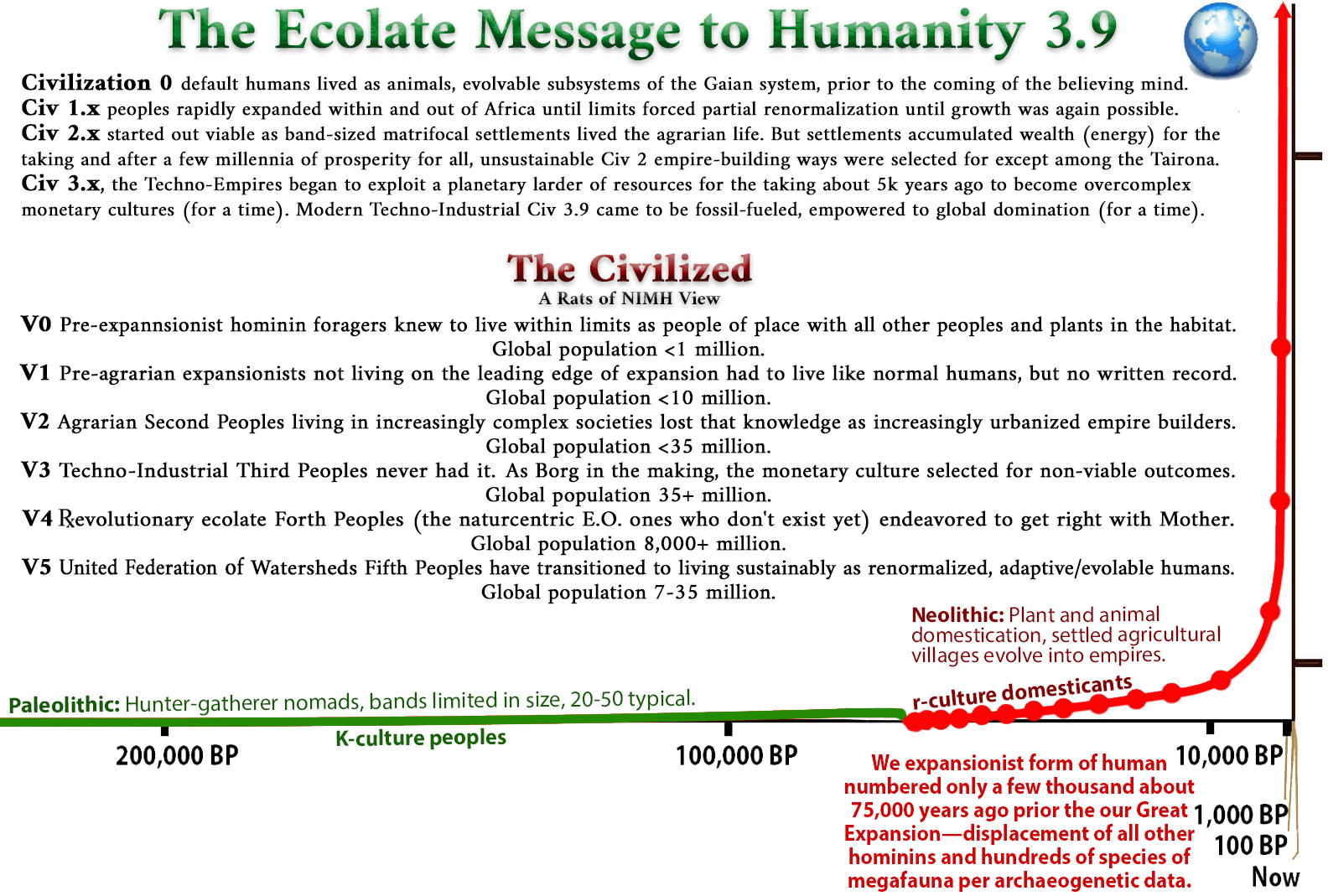
161. What if the Earth's population reaches 100 billion? Would food, water and mineral resources be capable of sustaining such large population? If not, what would it take to make it feasible and sustainable?
With ‘energy too cheap to meter’ Earth, as third rock from Sol, could support 100 billion, for a time, but only as a rock, the biosphere would be toast. Earth would be a Trantor visited by elites living on the Dyson sphere most of whose 30 billion trillion inhabitants would never get to spend any time on.
Zero and counting: We build a Dyson sphere. And then what?
But techno-optimists can be wrong on multiple levels, so don’t count on it.
Earth’s pet, livestock, crop and human populations are still growing, It is the rate of growth that is slowing. Human sperm count is declining rapidly.
Phthalates: The 'everywhere' chemical have unintended consequences.
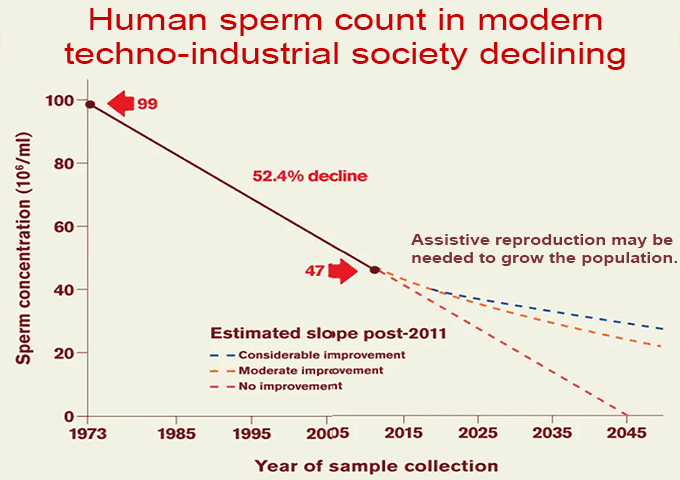
But with ‘assisted reproduction’, couples can still have as many children as they want (except poor people who can’t afford the treatments). But the fertility rate is also dropping due to increased stress and self-absorption that leads to urbanites marrying their avatar or otherwise not wanting to reproduce because kids are like so distracting. Calhoun studied the ‘demographic transition’ in rats and mice, but it was not caused empowering and educating the females.
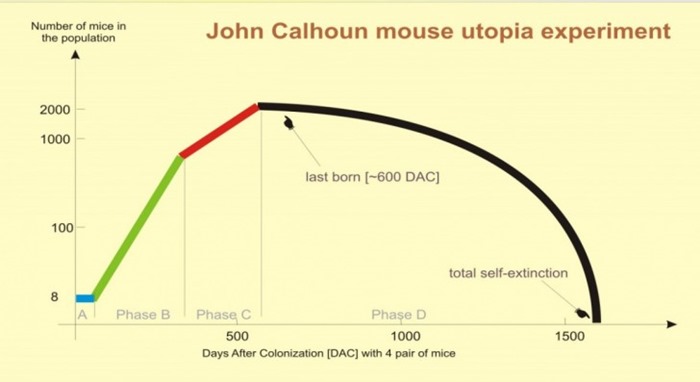
The CCP could implement a three-child policy quite easily and provide assistive reproduction for free, so don’t worry. Soon, 95 percent of humans would speak the same language.
As all economists know (the neoclassical welfare ones as the biophysical and ecological economists don’t know anything, are a bunch of know-nothings who refuse to look at the facts. The economy can easily support as many humans as it wants to.

Inform yourself of the facts, learn about carrying capacity and overshoot.
http://www.sustainable.soltechdesigns.com/over-carry.htmlOur collective inability to think about the possibility that there are or ever could be ‘too many people’ on the planet has a long history that goes up to the time I am typing this. Ouora is one source of evidence. There are several questions on human ‘over’ population with over a hundred answers. Pick all of them and spend some hours scanning the answers and sorting them into sets of essentially the same answer. Do it as a citizen science project. Instead of watching another movie or episode of whatever, do it.
Assume that most of those who answer questions on Quora think they know enough to have an opinion—not that they do, just think they do. So the data reflects the opinions of experts, whether academy vetted or not (as part of your study, note whether the answerer has a background in a field at all relevant to the question). Some people are more likely to know enough to have an opinion. For example, Richard Feynman is viewed pretty much by everyone who knows enough to do advanced physics as no ordinary genius. Feynman said, “Science is the belief in the ignorance of experts.”
Was he talking about self-accredited know nothing experts from the hood like me? No, he was talking about academy vetted experts like he worked with. My suggestion is that you listen to those who endeavor to listen to Nature who has all the answers. Then ask Nature questions and listen to the still small voice her data speaks. To be a bit more helpful, here’s a short, readable intro:
World scientists’ warning to humanity — Rex Weyler
Rex Weyler ends by noting: "As an ecologist, I feel compelled to ask myself: if the last 50 years of environmental action, research, warnings, meetings, legislation, regulation, and public awareness has proven insufficient, despite our victories, then what else do we need to do? That question, and an integrated, rigorous, serious answer, needs to be a central theme of the next decade of environmentalism."
The Fundamental Failure of Environmentalism
On his 80th birthday scientist and environmental activist extraordinaire David Suzuki noted that despite some victories of the David Suzuki Foundation and other efforts by environmentalists over the decades, that meanwhile "the pace of planetary destruction has not slowed ". Maybe there are no political solutions. Maybe any "integrated, rigorous, serious answer" will be wholly outside humanity's (including political activists to full-on eco-fascist revolutionary environmentalist's) current Overton window of thinkable discourse—for a time—yet know that things change, "this too, shall pass away", so learn now while access to viable information is still out there.
And always vet the source first (e.g. Weyler, Suzuki and who, if anyone, is publishing them, media bias/fact checkers are your friend and so is Wikipedia if you understand its limitations and bias). ALL UNVETTED SOURCES ARE NOT SOURCES. Could a source know more than you do? Maybe. If so, maybe resist letting screens distract you and consider that:
WE WERE WARNED
(longer list here)
Population, Evolution & Birth Control 1964
A Collage of Controversial Readings [from Han Fei to Garrett Hardin]
A Blueprint for Survival 1972

Limits to Growth 1972
Overshoot: The Ecological Basis for Revolutionary Change 1980
A Planet for the Taking 1985
An Appeal for Joint Commitment in Science and Religion 1990
Elder Brothers' Warning 1990
World Scientists' Warning to Humanity 1992
Joint statement by fifty-eight of the world's scientific academies 1993
The Anthropocene: conceptual and historical perspectives 2011
Aluna: Elder Brothers' Second Warning 2012
Consensus Statement from Global Scientists 2013
World Scientists’ Warning to Humanity: A Second Notice 2017
Worsening Worldwide Land Degradation Now ‘Critical’ 2018
Living Planet Report of 59 global scientists & overview 2019
The State of the World's Biodiversity for Food and Agriculture 2019
Nature’s Dangerous Decline ‘Unprecedented’ (IPBES) 2019
World Scientists’ Warning of a Climate Emergency 2019
A Discussion and Call to Action on Global Catastrophic Risks 2020
(38 in roundtable, Part 1: Warning. Part 2 and 3: no 'real solutions' considered as consensus limits thinking.)
Wildlife in 'catastrophic decline' due to human destruction, scientists warn 2020
Limits to Growth Updated 2020
International Scholars Warning on Societal Disruption and Collapse 2020
Underestimating the Challenges of Avoiding a Ghastly Future 2021
Freshwater fish in 'catastrophic' decline 2021 BBC summary
FINAL REPORT- Delivering the Human Future 2021 No real solutions
(The world needs a ‘survival revolution’ on a scale far larger than the ‘industrial revolution’)


162. What is the origin and rationale of sustainable development goals?
It is a consensus list of UN wordsmith agreeable goals that are non-binding and have no effect on business-as-usual development. Creating the goals and talking about them feels like one is doing something, which feels good.
The trajectory of modern techno-industrial society, now global, is locked in. No one is in the saddle ('things are in the saddle and ride mankind' Ralph Waldo Emerson 1844). There are smoke filled rooms of elites who pretend to manage the affairs of state/corporation, but they can only do what works to keep them in power and privilege for a time, i.e. pursue their short-term self interests like everyone else while pretending not to.
World leaders and the public have been warned:

Goals that actually would change our trajectory if binding and implemented within five years are outside consensus thinking.
We will keep on keeping on until we hit the wall of biophysical limits and can’t. Sorry about that.
163. Can we reconcile the need to intensify agricultural production system versus environmental sustainability?
The ‘need’ to support large populations of humans, livestock, and pets is the basis for unsustainable intensive agriculture and has been for about 10k years. Modern agriculture is a set of ways and means for directly and indirectly turning fossil fuels into food, which is not remotely sustainable. Agriculture is the proximal cause of most environmental destruction, e.g. turning forest into tree farms/fields/pasture and biomes into monocultures. Currently humans and their mutualists occupy 80 percent of Earth land surface and use/take well over 95 percent of its environmental productivity to support humans (maybe 4% of mammalian biomass is 'wild' meaning 36% is humans and the rest livestock, e.g. cattle). The 20 percent for Nature is mostly desert and arctic tundra. Apart from urban/industrial sprawl (<3%), the rest of the human footprint is some form of agriculture. You cannot reconcile a metastatic cancer with good health.
Anthropogenic Biomes
Anthromes, the human footprint on a planet for the taking
An example of answers starting with an intro paragraph and perhaps image to which the rest is a copy/paste of mostly links to bigger picture thinking.
Our collective inability to think about the possibility that there are or ever could be ‘too many people’ on the planet has a long history that goes up to the time I am typing this. Ouora is one source of evidence. There are several questions on human ‘over’ population with over a hundred answers. Pick all of them and spend some hours scanning the answers and sorting them into sets of essentially the same answer. Do it as a citizen science project. Instead of watching another movie or episode of whatever, do it.
Assume that most of those who answer questions on Quora think....
164. What has the most potential to spark the downfall of our civilization?
Scarcity induced conflict that increases scarcity.
As Steven Pinker notes, the level of conflict has actually declined in modern times, but not, as he tells it and most members of modern techno-industrial society want to believe, because of our becoming more enlightened (better).
Modern growth, enabled first by deforesting Europe in early modernity (1450–1750), then eastern North America by the 1870s (that increased farm/pasture lands/food), dramatically transitioned to exploiting a planetary larder of fossil fuels on an industrial scale resulting in the Great Acceleration of about 1950 when growth became clearly exponential from one decade to the next. Such growth is one-off, for a time, and is not remotely sustainable.
So the last 300 years have been years of increasing per capita energy and material resource use. The rapid use of fossil fuels enabled, aside from building great monuments, fossil energy to be turned into food faster than the population was growing, resulting in short-term prosperity (and inequality) that most beneficiaries of believe is created by human ingenuity (‘progress’) and view as proof of human exceptionalism and supremacy (dominionism).
The empire we are all products of and serve is the first, thanks to the planet’s fossil fuels (hundreds of million of years in the storing), to become global. It may last somewhat longer than the average for the prior millennium, but is vastly bigger and may fall harder than any prior empire.
What will spark descent could be one group’s perception of some offense, real or imagined, that must be avenged, but the most likely cause of global conflict will be scarcity, real or perceived, that could be of anything believed to be ‘needed’, such as electric power to run ACs or charge electric cars. Or food, as food actually is needed to keep on keeping on. Modern political animals conditioned from birth to feel like the ‘special’ consumers they are repeatedly told they are, will not starve to death quietly (without blaming someone and eating the seed corn as our ancestors often did who were not posterity blind).
Someone will have to be blamed and held accountable for any shortage, someone other than those with complaints and a sense of entitlement. Conflict will increase, increasing scarcity as usual (prior to last fossil fueled 300 years). Conflict will increase and things won’t get better. Scarcity induced conflict will be what it is and always has been: a downward gyre of death and destruction. Who inherits the rubble won’t matter. When the Indus Valley Civilization collapsed, history failed to record who won (inherited the rubble). No literate humans survived the fall.
There may be a remnant population, but after some centuries of environmental restoration, they will likely, as usual, repeat the pattern. But never again on a global scale (we have no bragging rights as it was not our clever ape ways that enabled the Great Acceleration).
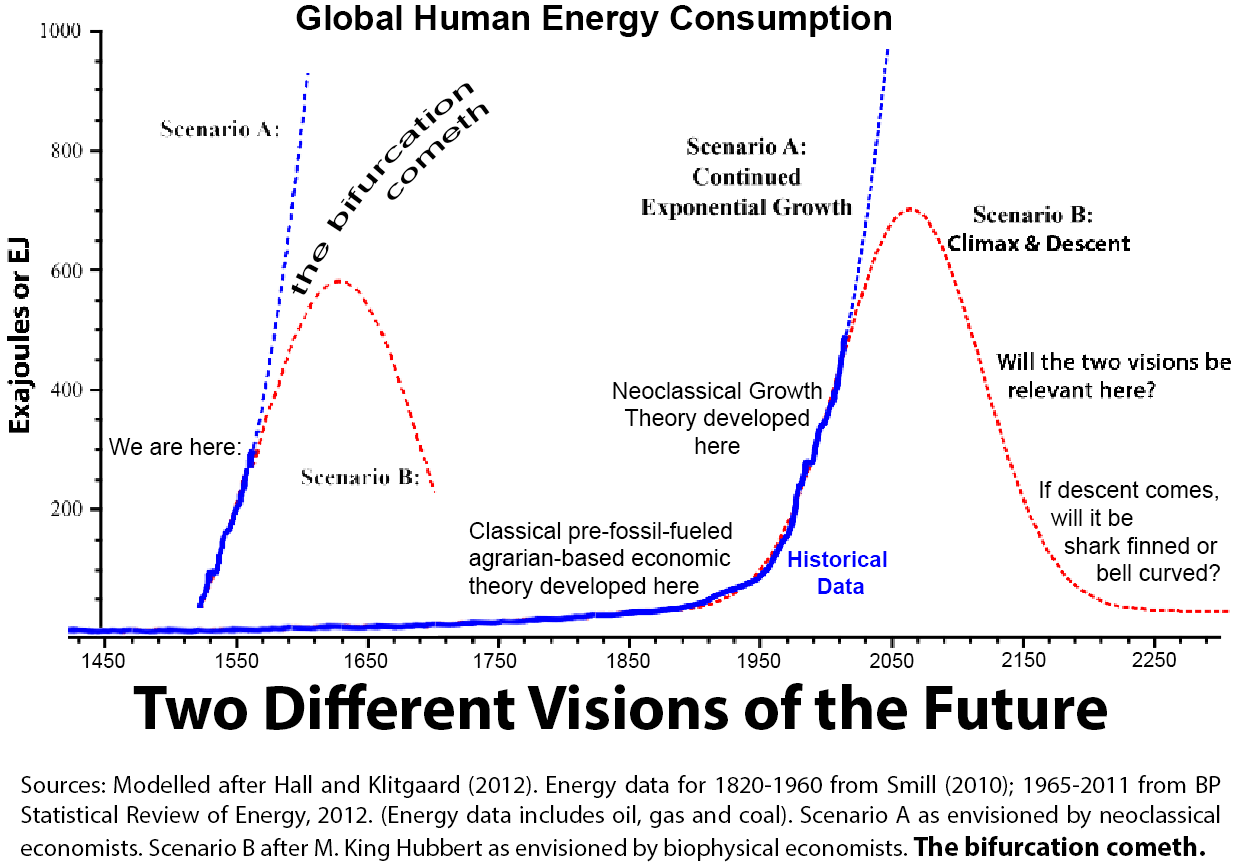
165. After hundreds of thousands of years on Earth, what lesson do you think humans really should have learned by now but we still have not learned?
Let’s say you are 34 years old. You’ve been alive for 300,000 hours. About ten thousand hours ago (14 months ago) a cell turns into a metastatic cancer cell, and because “growth is the ideology of the cancer cell”, it prospered greatly, conquering vast domains, founding metastatic colonies that build monuments to the Great Ozymandias, the name of the first empire building cell. You are in hospice care and ask, “what lesson should the cancer cells have learned by now but still have not learned?”
The question should be, what lesson did the cell forget 14 months ago that allowed it to prosper greatly by growing, metastasizing and growing at the expense of surrounding tissue?
It failed to live within limits as a normal somatic cell and started to behave as if it were not the body. It sought to maximize empower (MPP) in the short term even though doing so, destroying the system one is a subsystem of—exceeding carrying capacity unto plaque-phase overshoot, is fatal/degrading to the system (e.g. an organism or biome) and all the organs, tissues, and cells, normal and abnormal, that depend on its health and well being.
Imagine giving each of your cancer cells a stern talking to, with lots of diagrams and graphs of what will happen if they keep on keeping on. An incredible 99 percent are convinced to give up on growth and return to becoming normal soma cells. But 1 percent, 78 million cells, are deaf to your pleadings and they beget daughter cells that also are deaf. Your demise would merely be delayed.
But if the 99 percent did more that stop growing, but did whatever they had to to stop others from merrily metastasizing, then you might live another 34 years and decide to do whatever you needed to do to stop others from working to grow the economy. Stupid is as stupid does.

Life may be like a box of chocolates (a planetary larder of fossil fuel), but there is only so much chocolate in the box. And then what? What you believe the answer to be won’t make it so.
166. Is there any solution to mass fishing and farming with a constantly growing human population?
Humans are extracting resources from land and sea without an ability to actually set limits that would prevent species extinction, currently causing over a 1,000 fold greater increase than the pre-Anthropocene rate of species extinctions on a pathway towards causing a 10,000 fold increase by the end of the 21st century.
We are tapping into a planetary larder of fossil fuels that is enabling, for a time, our modern techno-industrial society to do what it has done, is doing, and will keep on keeping on doing until it can’t. Energy (and our lack of foresight intelligence) is the enabler and with its decline our ability to be rapacious will decline.
Note that tankers, on any given day and hour, are moving fossil fuels upon which all other movement, production, and consumption largely (85%) depends. Shipping is one form of transport.
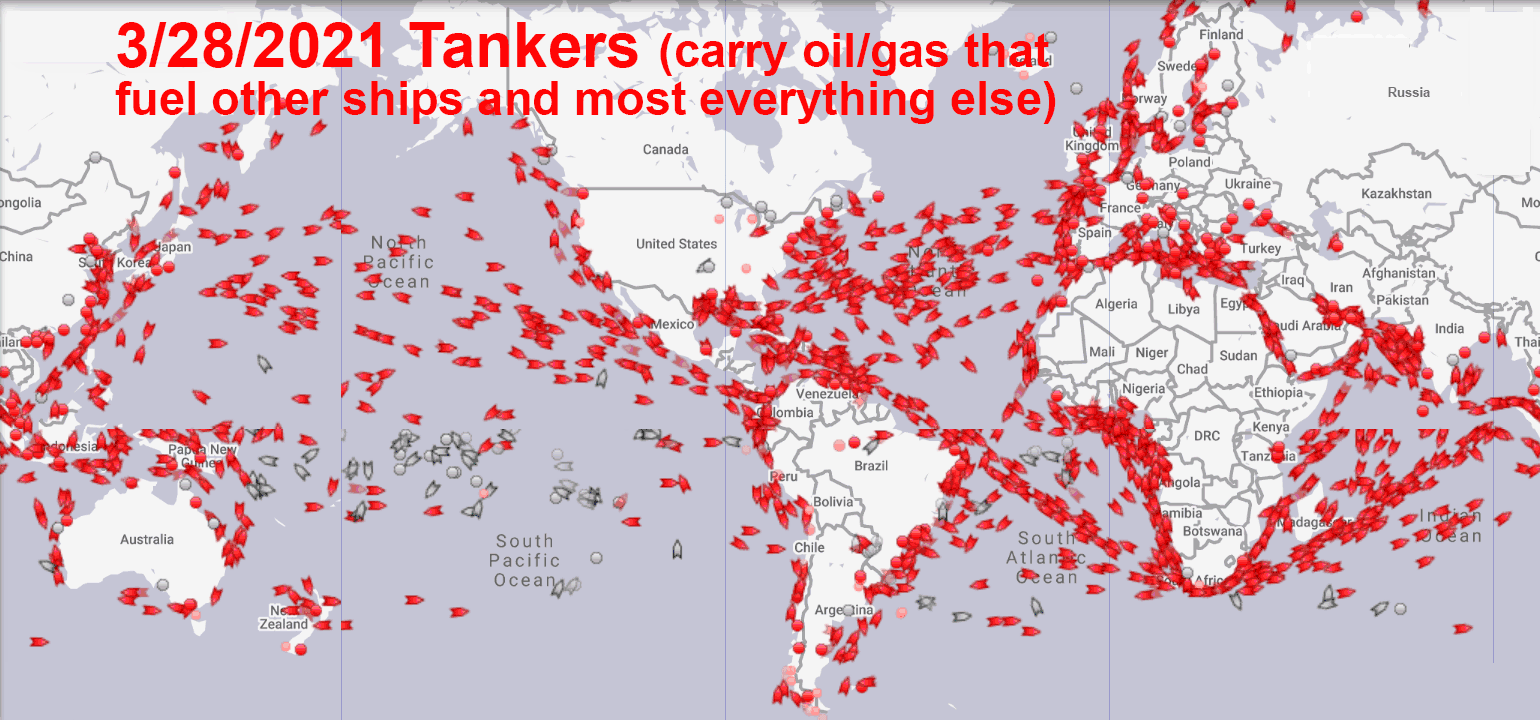
When most trucks, trains, and planes stop, there will be a Great Simplification and many problems will be solved. In perhaps 10–15 million years, Gaia will llikely recover (new species will evolve).
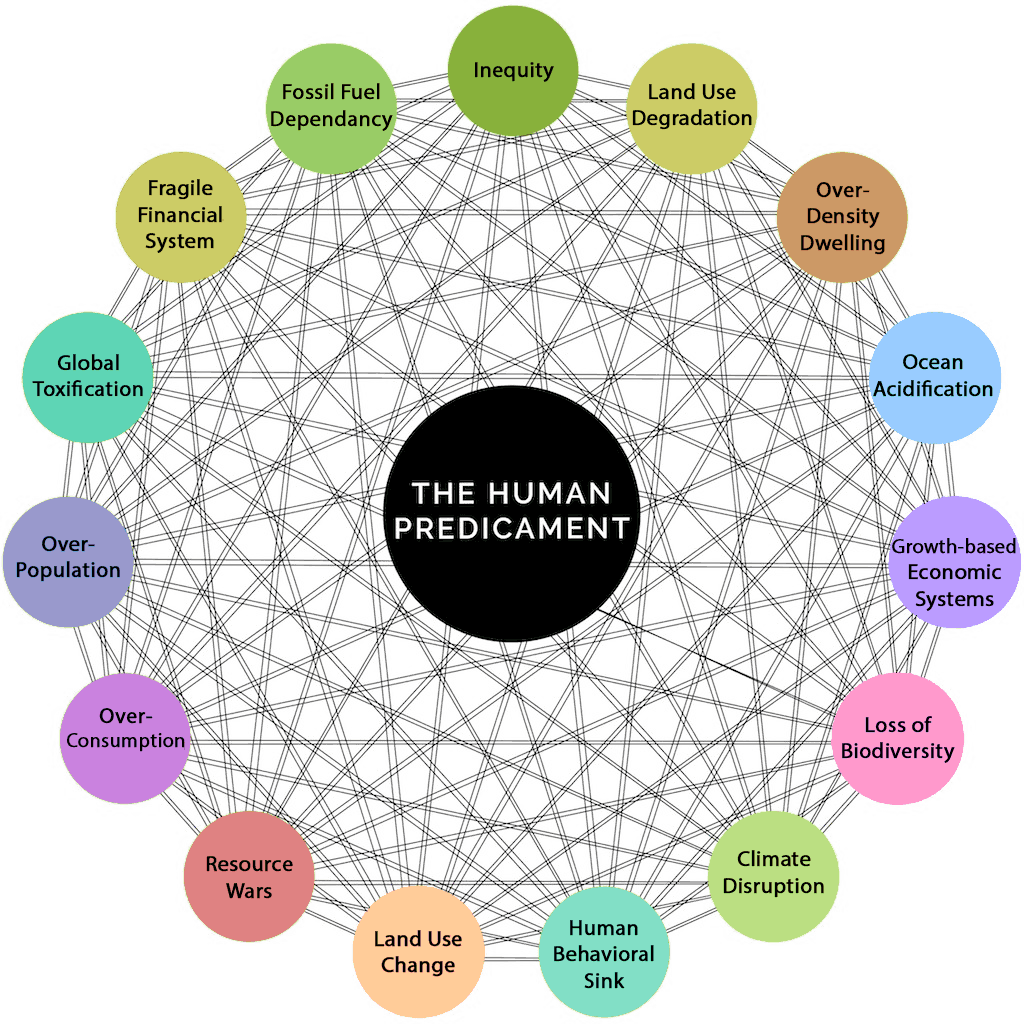
For some reason the educational system fails to graduate (enough) humans able to understand the human predicament.
167. If the human population continued to grow at an exponential rate forever, what year would there be a trillion people on Earth?
A biologist would want you to specify a believable growth rate (25,550%/year or doubling daily is not for humans) and note that any steady rate of growth or degrowth is unsustainable. There is never any steady state of growth in the universe. All populations fluctuate. It is known as the ‘pulsing paradigm’. Humans went Out of Africa and before agriculture about 10K years ago numbered maybe 5 million, but the increase in the rate of growth was unnoticeable within a human lifetime, unlike today, If you were born 80 years ago, there are now 5.6 billion more people on earth. Ask a biologist what could go wrong with that. Carrying Capacity and Overshoot
The current human population growth rate is 1.1%, but let’s go with 1%. There are about 7.9 billion humans and at 1% the population will be 15.8 billion in 70 years. I have no illusions that any steady rate of growth is possible. But for humans, a 1% growth rate is easy. With celebrity endorsement and financial incentives if needed, a 1% growth rate could easily be maintained if it were biophysically possible on spaceship Earth to do so. If it were, perhaps by building a Dyson sphere and using all energy from the sun, then the human population would reach 1 trillion by about 2500 CE.
I suppose that as there are climate experts who deny anthropogenic climate change, there may be a human ecologist or population biologist out there who thinks Earth can support more than 2 billion humans sustainably, but I can’t name one. One expert thinks Earth could support 1 trillion people, but so far as I can tell, economists don’t know enough about the dynamics of biophysical systems to have an opinion.
David Suzuki Is Right: Neoliberal Economics Are ‘Pretend Science’.
https://seekingalpha.com/article/4153589-dr-charles-hall-laws-of-nature-trump-economics
https://faculty.washington.edu/gmobus/Energy/Hall_IJTR_Article_Vol1_No1(2).pdf

168. Does our civilization have a future?
Good question, Jerry, if only for the variety of answers from across a spectrum of non-consensus opinion. By ‘our civilization’ I assume you are referring to everyone who could possibly read this with Google Translator if needed, i.e. all who are products of and serve modern techno-industrial society which is now global. I call it the Euro-Sino Empire as it began in the Euro region (with brief Americo phase late 20th century) and will end in the Sino region. In the 1980s M. King Hubbert called it the ‘monetary culture’ as distinct from a potential civilization based on the ‘matter-energy systems’ worldview.
Tomorrow is the future and modern techno-industrial (MTI) society is very likely to be around then, even a year from now or ten. Guy McPherson is Professor Emeritus of Natural Resources and Ecology & Evolutionary Biology and in 2014 he predicted all humans would be extinct (due to climate change) in ten years. He is likely to be proven wrong in three years, but in one hundred years? One group came up with an absurd 9.5% chance of human extinction in 100 years. Ten percent maybe, plus or minus nine, would better reflect uncertainties, but near-term (<100-500 years) human extinction is entirely possible if unthinkable to 99.9999% of Anthropocene enthusiasts.
I’m guessing a remnant population of humans, livestock and pets will pass through the coming (foreseeable) bottleneck. My concern is that the culture, some form of business-as-usual empire building, will repeat the pattern of overshoot and descent on a regional level until Nature selects against it as a non-evolvable dissipative systems, e.g. cancers. This will further and maximally degrade the planetary biosphere, so human extinction near-term could be the better outcome from the POV of all other life on the planet except for pets, crops, livestock and some viruses/pathogens.
My other concern is that MTI culture does survive intact and goes forth to colonize other star systems as a Borg-like empire builder, or if confined to Earth, to become Morlock-like as H.G. Wells feared.
Oh, but maybe when the monetary culture’s promises of everlasting growth can no longer be believed in, humans could agree to new ‘rules of the game’ that select for a different outcome, e.g. a viable ecolate civilization.

[The early ecolate came to be called the 'E.O. ones', mindless followers of the eco-fascist anti-human E.O. Wilson who advocated for merely a Half Earth for humanity. The EOs came to accept the term but translated it as 'ecolate ones'. Civ 4.x would be transitional, likely taking 8-12 generations be become Civ 5.0. It's been a long way up as it will be down, see full graph.]
But I’m an extreme cornucopian optimist, so 99.9999% of Civ3.x humans have no interest in transitioning to a Civ4.0 that could maybe transition to a Civ5.0, aka the satanic New World Order/Ecological Civilization. And I’m an ignorant know-nothing from the hood who just doesn’t get it. So consider: Will Modern Civilization be the Death of Us?
https://www.youtube.com/watch?v=U3GB191UDiI
169. With technologic advancements in agriculture and consequently the increase in productivity, what's the maximum population the Earth can sustain before worldwide famine happens?
By 1798 in Europe, the population was growing fast enough to be noticeable and of concern, though still far slower than than in the far more fossil-fueled 19th century to come. Agricultural productivity increased in 18th century Europe, and after 1750 more people got married younger. The driver was the Industrial Revolution, the early part of which comes with Newcomen’s first coal powered steam engine in 1712 to pump water from flooding coal mines.
In the feudal system, wealth increases with labor (convertible to soldiers for feudal warfare/conquest) and if children can be supported until they can work, then that is selected for. Until the food supply increased, they couldn’t be, hence late marriage to avoid starving children.
A few asked, ‘and then what?’ Population can easily grow geometrically (then and now) in all species and exceed food production.
What no one understood until the 20th century was that fossil fuel energy can, directly and indirectly, (via technology) be turned into food energy. If the population increases 8-fold and food production increases 10-fold, then what’s not to like? What’s the problem? For a time, food production isn’t limiting. There are no negative feedbacks to inform the 99% that they (or their posterity, e.g. us) could have a problem.
Vast increases in industrial agriculture in recent decades, especially in Asia and places like Indonesia and Brazil, have managed to keep the global food production system going by turning vast amounts of fossil fuels into food (and deforesting vast areas). Technology is required, but is not what does the work. Without diesel, a tractor becomes a lawn ornament and future relic to dance around.
While the foundations of the Green Revolution were in place in 1968, many ‘experts’ didn’t see it coming. Selecting plant cultivars able to maximally benefit from industrial fertilizer, weed control, irrigation, and pesticide inputs enabled production to increase about three-fold (add needed high-power harvesting/transport/processing needed to produce the bite of food on the end of your fork that traveled probably 1500 miles to get there that is thereby about 9 parts fossil fuel energy and 1 part solar energy).
But even Norman Borlaug, who was given a Noble prize by humans who assumed he had done them a favor, noted that his work had merely bought humanity more time to address limits to growth issues.
We didn’t. Much easier to deny, deny, deny. We are using fossil fuels to pump aquifers dry, convert every arable hectare into farmland or pasture where soil erosion exceeds soil formation, to seine the oceans of fish, and grow food in vast greenhouses or even old warehouses with electric lights and heating for winter lettuce production, none of which is remotely sustainable.
Oh, but we’ll build vertical farms, a hundred stories high with grow lights on every floor, robots will do all the work and increase production at least a hundred-fold, and… the assumption is that there is an illimitable source of energy ‘too cheap to meter’ that will always be there, and that all needed material resources, water and mined minerals are out there for the taking (and that taking without giving service of equal value would be ethical because it is all about us). Such thinking (storytelling) is entirely belief-based and comforting, for a time.
The maximum peak population won’t matter much. The bigger we get, the harder we’ll fall, the more there are to die. We are in a one-off plaque-phase overshoot event.
Hitting 8 billion is likely, but beyond that, 9 billion? 10 billion? Anyone’s guess, but some guesses are more informed than others, if 8–10 isn’t good enough, guess 9.x billion peak, followed by descent as night follows day. Sorry about that.
The great error, firmly embodied in the question and the modern mind, is that the increase in production (food and stuff and people and livestock) in the last 300 years is due to clever ape technology. Technology may work, but it does not do work. Only energy does. Being energy blink, we are poised to self-destruct.
We moderns are also time (posterity) blind which precludes foresight intelligence. The foresight intelligence of a Malthus, Mill, Thoreau, Lotka, Leopold, Hubbert, Forrester, Carson, Hardin, Boulding, Ehrlich, Bartlett, Odum, Meadows, Daly, Catton, to the World Scientists Warning to Humanity of 1992 and many increasingly desperate warnings since have failed to serve Growth’s mandate and so all doomers must be cancelled if they can’t be ignored. Our collective ability to ignore, however, is reaching a heroic crescendo, bitches.
Technology, without the sapience to use it within limits, is not your friend, but our ticket to extinction.
By the way, I was trained to be an agronomist with degrees in crop and soil science. I never worked in the field because, as an expert I assessed industrial agriculture to be non-viable, long term (I didn’t merely let the professors decide what I needed to know but also, as an autodidact, learned systems ecology to manage agroecosystems which is what I would actually need to do).
it was obvious that without fossil fuel inputs I couldn’t grow any more food than a traditional Hopi farmer. Teaching the Hopi farmer to increase the yield on his land 10-fold, for a time, would be utterly unsustainable and unethical, condemning his descendants to a mass die-off.
170. Who has the answers to humanity’s problems?
Who, as in who should humanity listen to? If you imagine there is some supreme, or even advanced, being ‘out there’, then question answered. You’ll give whatever answer feels good.
The systems ecologist, Howard T. Odum, famously among his students, would note that ‘Nature has all the answers, so what is your question?’ How does the Cosmos, or any part of it, work? If the answer (Odum’s) is obvious, then question answered. Listen to Nature who has all the answers. Nature is a complex system of subsystems all the way down to you and atoms and hadrons and leptons and quarks and space-time energy. We don’t actually know anything, we at best iterate towards knowing, sort of. Gaia alone can answer your questions if you can ask them. But what questions could a dog ask about calculus? If you want to know where’s the rat, ask a dog. We all have limits.
How might humans persist in living on the planet as the millennia pass? No one knows; no one gets a vote. We can guess, then test. Best to do so as multiple societies, I’m thinking 25k might be enough. One global empire, like the one we live in and serve (i.e. the monetary culture), is one egg in one basket. The assumption is that we are too big to fail. Poor, profoundly ignorant, baseless assumption.
The only humans you might consider listening to are those who endeavor mightily to listen to Nature. This would include some scientists, but some poets also endeavor mightily. I don’t waste time studying anyone who doesn’t listen to the small still voice of Nature. Listen to all who listen to Nature, then ask Nature. ‘Go forth, under the open sky, and list to Nature’s teachings’. Learn to think better, critically, without believing anything, and constantly test your best guesses knowing only that you could be wrong about everything.
Otherwise, you’ll become barking mad like all the other pundits out there. Being considered an expert by others, or even wise, may feel good, but Nature doesn’t care what feels good to you. So endeavor to understand the world system.
171. What is an essay about ecological literacy?
The human ecologist Garrett Hardin defines three pillars of the educated mind: literacy, numeracy, and ecolacy. Today’s educational (schooling) system, as it has for several hundred years, selects mainly for literacy. Numeracy for some specialists is encouraged, but for true intellectuals is discounted or disparaged. The educational system, and we products of it, are so inecolate as to not even know it, or be able to know it.
As Hardin notes,
I think we can find no better guide to inquiry than an aphorism of August Comte (1798-1857): "The Intellect should always be the servant of the Heart, and never its slave." Comte was the first proponent of "Positivism," a philosophical approach generally regarded as "hardnosed. " Note, however, that the philosopher gave first place to the Heart. Values are paramount: it is the role of the Intellect to find a way of achieving what the Heart desires. But the Heart, by definition, can scarcely be expected to be very intellectual; its uninstructed impulses may, in fact, be counterproductive of its goals. The task of Intellect is to examine these impulses and, in its role of faithful executive officer, restructure them productively….
At the deepest level our problem is an educational one. In the Western world literacy has been taken as almost synonymous with education; yet a generation ago some insightful person (I don't know who), asserting that literacy is not enough, said that we need also numeracy, the ability to handle numbers and the habit of demanding them. A merely literate person may raise no question when a journalist speaks of "the inexhaustible wealth of the sea," or "the infinite resources of the earth." The numerate person, by contrast, asks for figures and rates. Perhaps it takes more imagination to think with figures than with ambiguous, airy generalizations, but the mind can be helped by graphs, which Bishop Ores me invented in the 14th century. Graphing is a precious resource of numeracy. What a commentary it is on the slow progress of education that today's leading journals, generally referred to as "intellectual"-Harpers, Atlantic Monthly, Kenyon Review, and the like-never use graphs to illuminate ideas. ("Have you noticed," asked the mathematician G.H. Hardy, "how the word 'intellectual' is used nowadays? There seems to be a new definition which certainly doesn't include Rutherford or Eddington or Dirac or Adrian or me. It does seem rather odd, don't y'know."14) Six centuries have passed since Oresme-six centuries of glorious progress in scientifically enriching our vision of the world: is it not time that our self styled "intellectuals" become numerate as well as literate?
I think a good case can be made for a third level of education, the level of ecolacy. This is the level at which a person achieves a working understanding of the complexity of the world, of the ways in which each quasistable state gives way to other quasi-stable states as time passes. The three levels of education can be epitomized by three questions:
Literacy- What is the appropriate word?
Numeracy- How much/how many?
Ecolacy- And then what?
Ecolacy is short for systems science literacy (start with Donella Meadows, Thinking in Systems: A Primer). It is founded on and is a plea for foresight intelligence which is not selected for by modern techno-industrial society, nor its schooling system. I think a good case could be made that of the three pillars, only ecolacy is essential for human persistence with the planet.
In 1985 there were too few products of the schooling system Hardin served who could or would read his essay with any understanding as some level of rudimentary ecolacy, or merely an impulse to inquire, was needed. If his essay were published today, it would be self-published on a blog having maybe eight readers (or even 800), which would not be enough to change our consensus narrative or our trajectory (i.e. 0.00001% to 0.0000001% would not be enough).
An Ecolate View of the Human Predicament
172. Should less populated countries invite people from more populated countries, so the world will be balanced?
I live in a watershed that is somewhat larger than the island of Unguja. There are about 42,000 people living in ‘my’ watershed, which I share with some trees, crows, and even a few bears. The current population is 17 times larger than the environmental productivity this watershed could support before industrial agriculture and the transportation and production/processing system (and Indo-Europeans) was able to turn fossil fuel into food and transport it on average 1,500 miles to the end of my fork after being properly processed.
Unguja has 23 times the current population of my watershed, or 390 times more than the environmental productivity of this watershed could sustainably support without modern techno-industrial society diverting about one-fourth of the planet’s resources to this region (USA).
I’m a privileged white racist, but now that I have been properly educated, I listen only to my Heart, and so I invite 660,000 people from Unguja to come live with me (the crows and bears think there are already way too many humans here, but they don’t get a vote, so ignore them).
173. Is global food security achievable?
I was trained to be an agronomist and graduated with highest honors from CalPoly with degrees in crop and soil science with the goal of going overseas to help increase food production. I did not work in the field because I realized that without fossil fuel inputs from industrial society, that neither I nor any of my even cleverer ape colleagues could grow more food than our ancestors or those in developing areas using only sunlight and rain and perhaps a digging stick to grow food to empower humans and some animals to do the work needed to farm. What I realized was that I should go overseas and learn from traditional farmers who have been sustainably farming for centuries.
The cultivars that seemingly made for the Green Revolution will not grow and increase yields several fold without industrial inputs. Virtually all soils on every arable hectare are eroding 10 to 100-fold faster than new soil is forming, and this is also true for vast areas of tree farms that were once forest. Lightly grazed pasture lands may have soil erosion rates similar to natural grasslands, but overgrazing (maximum profitable grazing) is the norm and vast areas of soils have been and continue to be eroded to parent material.
Without fossil fuel inputs, direct (e.g. diesel running farm machinery) and indirect (nitrogen fertilizer made by turning natural gas to ammonia via the Haber process and then into other forms of nitrogen fertilizers and mining of remaining phosphate ores to make phosphorous fertilizers and fuel/electric needed to pump vast aquafers dry and…) modern techno-industrial agriculture is ‘not remotely close to sustainable’. About 9 of every 10 calories on the end of your fork, that on averaged traveled 1500 miles to get there after extensive industrial processing, is literally made of fossil fuels.
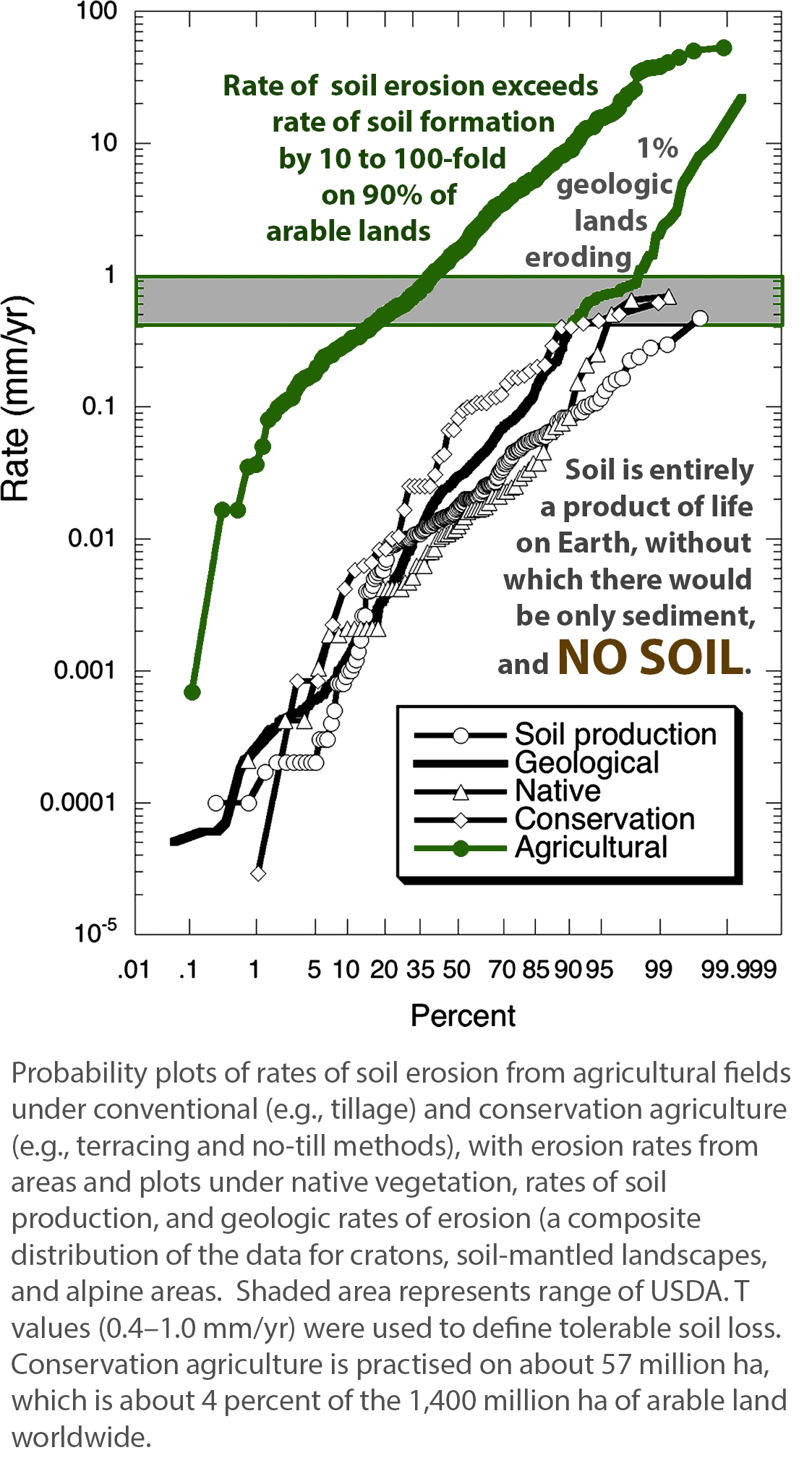
Soil erosion rates, among other myriad rates of change/growth, are UNSUSTAINABLE.
Unfortunately for posterity (mostly) and the biosphere, humans would rather believe (in sustainability, food security, etc.) than know (that modern techno-industrial civilization, the global monetary culture, is NOT REMOTELY SUSTAINABLE).
‘People would rather believe than know.’ —E.O. Wilson

174. What does the population density map look like?
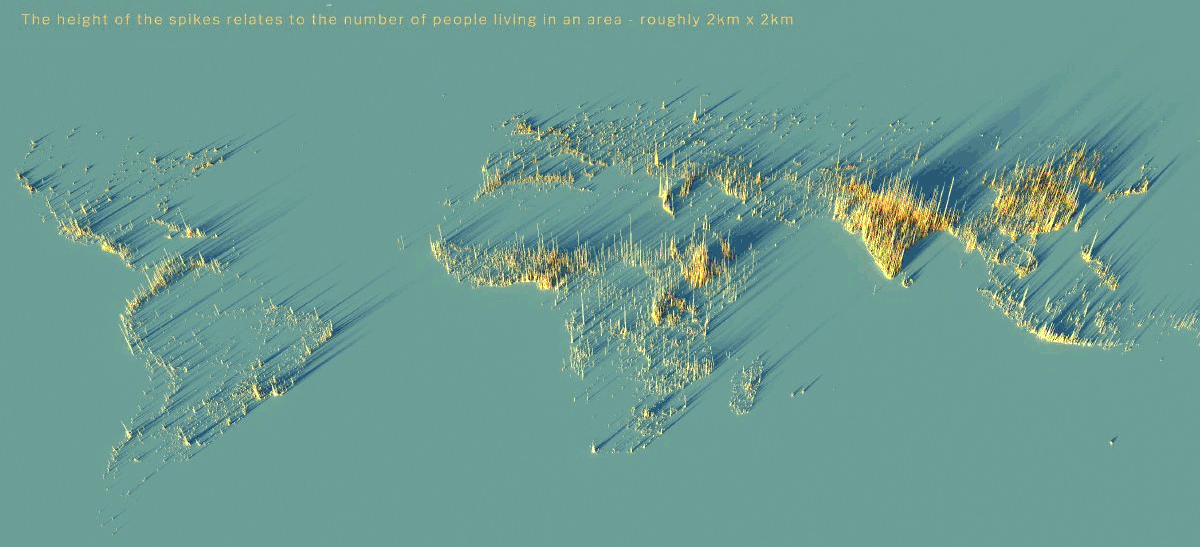
175. If all potentially available arable land is used to grow crops to sustain human population, how many people can the Earth sustain given the current agriculture technology and the foreseeable future's technological developments in agriculture?
The planet has about 14,800 million hectares of land, of which about 12,200 million hectares (82.4%) are biologically productive land, e.g. tundra (not bare rock or land covered in ice all the time or shifting sand). There are about 1,400-1,500 million arable (cropland) hectares out of a total of 4,924 million hectares of land used for agriculture: arable land (row crops) is 28.4% of all agricultural land, most is permanent pasture planted to domestic forage plants (68.4%), and permanent crops (e.g. vineyards, coffee/rubber/palm oil plantations, and orchards) are 3.1% of all agricultural land. Rangelands are natural grasslands pastured by livestock, plus shrublands, woodlands, wetlands, and deserts that are grazed by domestic livestock and perhaps some wild animals.
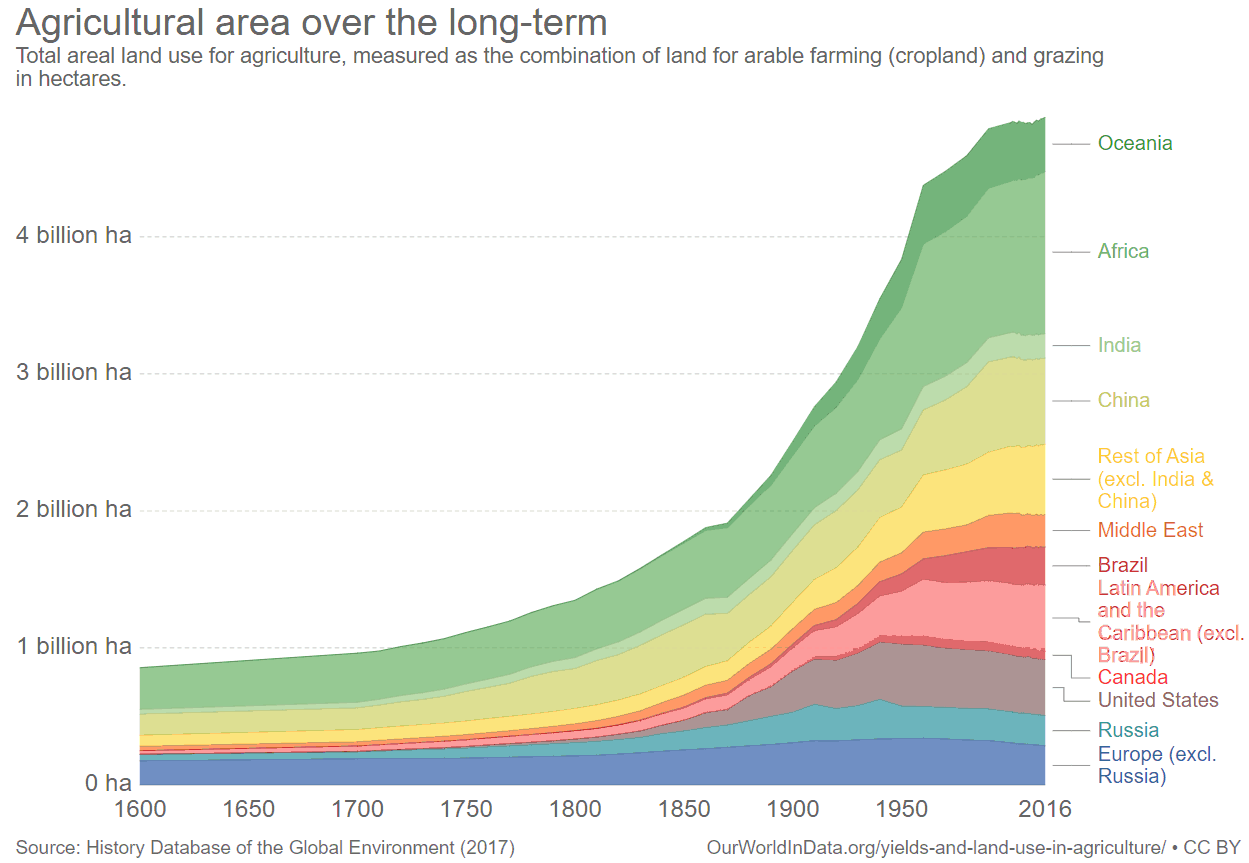
Note that the rate of growth in agricultural land area has slowed, is nearing climax. Most of the area is not being farmed or grazed sustainably. The percentage of the land surface of the planet in agriculture will peak and decline. as it has in Russia, Europe, and the USA. Don't expect any significant increase in area. Expect a decrease, likely to an area less that before the Industrial Revolution as fossil fuel inputs decline.
Not included are forested lands, of which there are still about 4,060 million hectares, down from 5,900 million hectares 250 years ago. About 7 percent is old growth forest, meaning it is protected for human recreational use, is too inaccessible to cut, or just hasn't been cut yet, such as large remaining areas of the Amazon. If you fly around the world using Google Earth and look down, what looks like forest is 93 percent tree farms waiting to be cut again. We may not eat wood, but it is a major crop. We don't eat it but the global economy does, along with mined lands that are very much apart of the human footprint as are roads and other land used to support structures. Modern techno-industrial culture views Earth as a planet for the taking, any part of it humans may find a use for. What is left will be viewed a worthless or developed for human recreational use and imagined to be natural.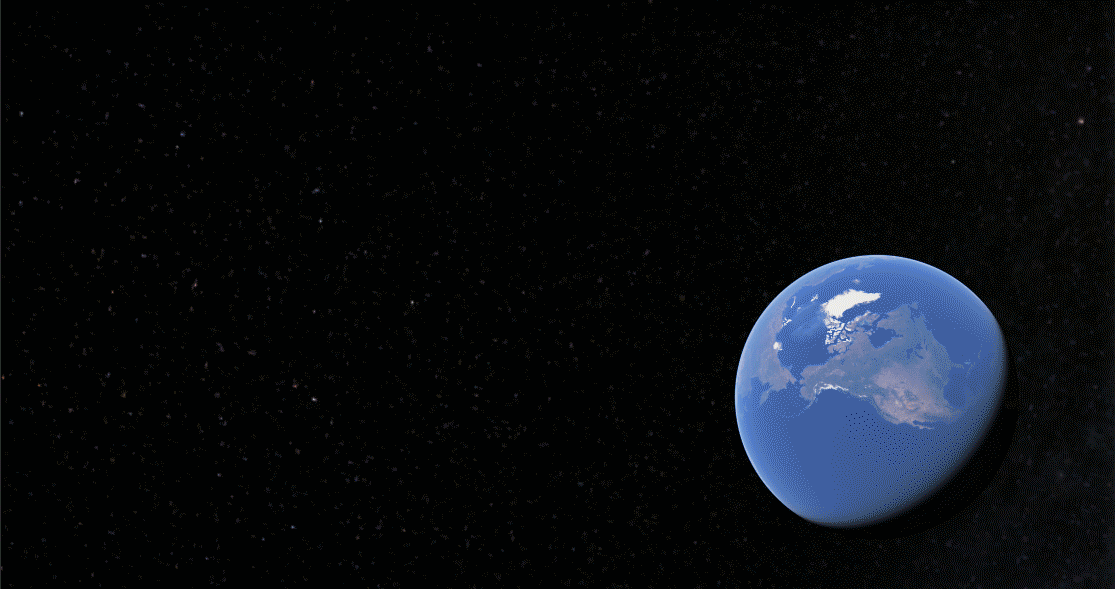
Yields per hectare reflect our ability to turn fossil fuels into food. There are limits to both cheap and available fossil fuel inputs and our ability to increase yields. Contraction of our food production system is foreseeable. When will the number of hectares used for agriculture climax globally? I don't know to the year, but this century is a good guess. When will the number of arable hectares peak and yields per hectare climax? I don't know, but....

So, how many people can the Earth sustain if smart humans find a source of illimitable energy and we terrace every hill and mountain, and desalinate sea water to irrigate anywhere we want, and run huge AC units to cool crops if it is too hot, and heaters to warm crops if it gets too cold, even grow crops year around in Alaska? Well, I'd guess maybe a trillion for a time, as food is not the only limiter to population growth.

How many people can the Earth system sustain long-term as the millennia pass without causing species extinction? The data and best guess of ecologists is in the 7 to 35 million range. Some optimists think Earth could support as much as 42 to 50 million, but only if humans work to serve Nature and not their short-term self interest. Consider Carrying Capacity, Overshoot and Sustainability: The Objective View.
I was trained to be an agronomist and graduated with highest honors from CalPoly with degrees in crop and soil science with the goal of going overseas to help increase food production. I did not work in the field because I realized that without fossil fuel inputs from industrial society, that neither I nor any of my even cleverer ape colleagues could grow significantly more food than our ancestors or those in developing areas using only sunlight and rain and perhaps a digging stick to grow food to empower humans and some animals to do the work needed to farm. What I realized was that I should go overseas and learn from traditional farmers who have been sustainably farming for centuries.
The cultivars that seemingly made for the Green Revolution will not grow and increase yields several fold without industrial inputs. Virtually all soils on every arable hectare are eroding 10 to 100-fold faster than new soil is forming, and this is also true for vast areas of tree farms that were once forest. Lightly grazed pasture lands may have soil erosion rates similar to natural grasslands, but overgrazing (maximum profitable grazing) is the norm and vast areas of soils have been and continue to be eroded to parent material.
Without fossil fuel inputs, direct (e.g. diesel running farm machinery) and indirect (nitrogen fertilizer made by turning natural gas to ammonia via the Haber process and then into other forms of nitrogen fertilizers and mining of remaining phosphate ores to make phosphorous fertilizers and fuel/electric needed to pump vast aquafers dry and…) modern techno-industrial agriculture is ‘not remotely close to sustainable’. About 9 of every 10 calories on the end of your fork, that on averaged traveled 1500 miles to get there after extensive industrial processing, is literally made of fossil fuels.

Soil erosion rates, among other myriad rates of change/growth, are UNSUSTAINABLE.
Unfortunately for posterity (mostly) and the biosphere, humans would rather believe (in sustainability, food security, etc.) than know (that modern techno-industrial civilization, the global monetary culture, is NOT REMOTELY SUSTAINABLE).
‘People would rather believe than know.’ —E.O. Wilson

176. What do scientists estimate the carrying capacity of humans to be for the planet?
The current low estimate is 2 billion when speaking to the public, i.e. any scientist who thinks ‘or less’ can add such words to 2 billion, but to actually give a number significantly less is to be judged by the consensus of global thought leaders to be dismissible, crazy, unthinkable.

A 2012 UN report summarized 65 different estimated maximum sustainable population sizes. Cited by authoritative BBC article in 2016.
Many of the experts consulted by UN policy makers giving high estimates were likely economists who deeply believe the economy will easily support 20 billion or even 1,000 billion given that humans are so smart and ideas like carrying capacity, overshoot, or crazy claims about limits to growth do not apply to humans.
I do know one ecologist who via email put the maximum sustainable carrying capacity question to his colleagues, about 30, and the highest estimate was 2 billion people and the low was 50 million.
E.O. Wilson, for example, estimates in writing maybe 10 billion, but when David Suzuki asked him in a one on one chat, he said that if people want to live like Americans, maybe 200 million. I would say 500 million is close to the average guess of those who actually know enough to have an opinion.
But once you can question why we should be thinking ‘maximum’, then eventually you might ask how many humans can live on the planet without causing species extinction or preventing new species to evolve to replace those of the Anthropocene extinction event we are causing. The range of best guess as to optima human populationl is 7 to 35 million humans on the planet. Carrying Capacity and Overshoot. Of course, 99.9999% of Anthropocene enthusiasts will roll their eyes contemptuously at any number less than 10 billion.
177. What would civilization look like if humans were naturally geared towards more long term thinking and living sustainably with the planet? Can humans ever evolve to be more like this? What type of temperament would this new sub species be like?
Despite the modern myth of matriarchal prehistory (as firmly believed in by many), necessarily hierarchical complex societies that have arisen over the last 10k years are not the nomadic hunter-gatherer norm over the last 2+ million years or so up to the beginnings of empire-building complex societies. Common chimp society is patriarchal in that no adult male chimpanzee is subordinate to any female of any rank. Bonobos, who evolved (like humans, the third chimpanzee) from a common ancestor with common chimps may have started out with the alpha male dominance pattern, but evolved a matriarchal society (that is patrilocal). Humans may have, sort of until recently, done so too. The alternative to patriarchy is no political archy. Feminists should consider being apolitical, but are anything but.
That matrilineal, matrilocal goddess preferring (to later alpha Big God submission) prehistoric humans existed suggests that this pattern must have been selected for over a long time period (e.g. 2+ million years) to have evolved. Prior to the spread of empire builders, female centered society may have been the norm. 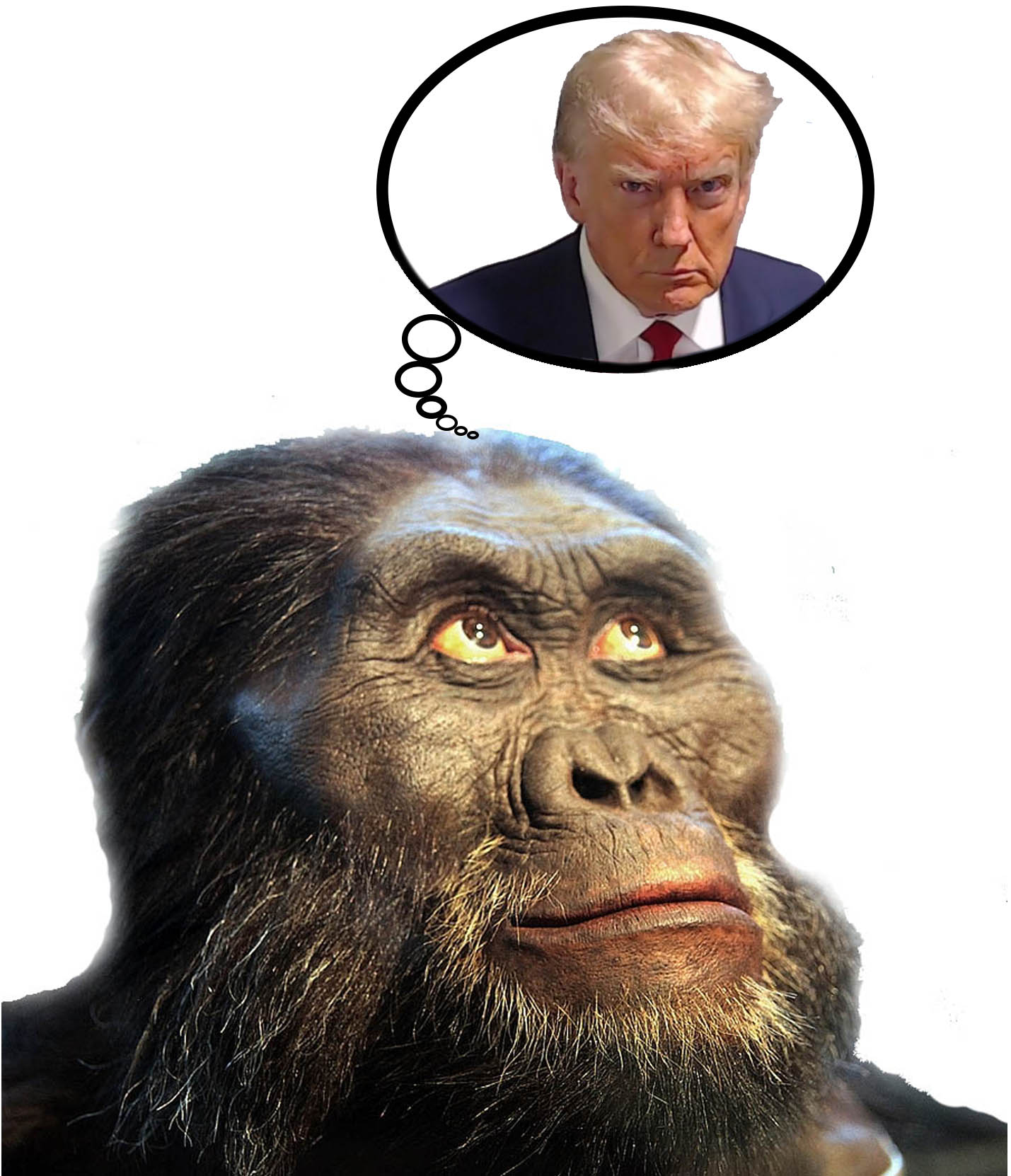 This suggests that patriarchy (prior to the spread of empire, or modern selection for the alpha male chimp pattern, may have been rare, a biological/anthropological atavism). The new pattern, however, does not imply that there were alpha females, so 'matriarchy' is a misleading and loaded term. Female centered, recognizing the natural superiority of women, implies what I think of as a de facto matriarchy that in no way implies that women rule as alpha females. In a cooperative, egalitarian apolitical society, a band of 20 to 50 people, no ruler is needed nor selected for in a cooperative society.
This suggests that patriarchy (prior to the spread of empire, or modern selection for the alpha male chimp pattern, may have been rare, a biological/anthropological atavism). The new pattern, however, does not imply that there were alpha females, so 'matriarchy' is a misleading and loaded term. Female centered, recognizing the natural superiority of women, implies what I think of as a de facto matriarchy that in no way implies that women rule as alpha females. In a cooperative, egalitarian apolitical society, a band of 20 to 50 people, no ruler is needed nor selected for in a cooperative society.
That prehistoric patriarchy existed is evidenced by the likes of the Indo-Europeans who, empowered my horses and cattle and weapons, spread out of the Steppes of Central Asia seven thousand years ago to conquer vast areas and spread their memes and genes (and language) widely. If those hunter-gatherers who transitioned to agrarian ways of settlement living were 'matriarchal', then, if women's modus operandi is not conquest, then goddess celebrating small agrarian settlements may well have been viewed as a resource for the taking by the patriarchal ones who prospered greatly as they spread to dominate vast areas on up to today's modern global techno-industrial ones who view the planet as for the taking (e.g. political/military/CEO/NCE types).
Humans were naturally geared towards more long term thinking and living sustainably with the planet and getting along with one another most of the time because failure to do so was selected against since the evolution of life began on Earth (and any elsewheres). Humans with technology are a new dynamic. They have hands to make weapons and plows and bombs, and brains to store information and language to pass information on to create a meme pool that, like the gene pool, that is evolvable. Whether the new complex adaptive system (CAS II) will be evolvable has yet to be determined. Dissipative, adaptive, but non-evolvable systems go extinct.
Modernity is usually said to have begun in Europe about 1450 CE with the printing press, but modern humans are empire builders and this pattern began 10k-12k years ago. By about 3k-4k years ago most humans were living in overcomplex societies vastly different from that of their ancestors, much like John B. Calhoun's rats and mice lived in their cornucopian confines compared to rats and mice living in Nature.
Can human complex societies ever evolve to be more like what works biologically for humans? If we need to evolve soon, next century, then evolving genetically, even with vast use of genetic engineering, may not be our better option as evolution is a guess then test process taking millennial to eons of time. There is nothing basically wrong with our genes, though some cleansing of the gene pool can be expected.
The question is can we change memetically, change 'the rules of the game', to allow humans to recover lost functional behaviors and learn to relive in band sized groups of 20 to 50 others one can literally trust with one's life. In small (under Dunbar's number) groups, no one locks their doors. Could those so living have two homes, a community home and a city home where they may go for a few days each month? A brief bout of city life would auto-organize as a complex society in which benefits could exceed harm provided that living in the city was not normalized, especially for children.
Compared to the hunter-gatherer life, the difference is that the city could have a library and autodidacts, children and adults, could have access to a vast treasure trove of information about life, the universe, and everything. After raising their family, some adults might live in the city to provide services as needed. Or if you needed a cobbler, you'd know which village to go to (by walking). There are details, but designs for viable civilization are thinkable. All, of course, would have to be non-business-as-usual, so not life as you know it.
What type of temperament would this new sub species be like? Well, in a viable sub-society, chest-beating alpha male types would be selected against. Communities would be mostly protected by men who would serve as apart of a militia willing to deal with community issues, but also to join with all other militia to protect all the communities in an area from would-be empire builders seeking conquest. This is a necessary function now and likely will be for centuries. Someday no militia would ever be called upon to defend themselves and their neighbors when all would-be empire builders give up, but militia members normally handle transport of stuff across their local area, such as trade items and materials, and so would keep on doing that. Cooperation would be normalized, so seeking short-term self interest, whether through criminal activity or acquisitiveness we consider normal, would be selected against.
The ultimate selector of what works is Nature, aka Mother Nature. When a visitor comes to a village or city, men would more likely meet, greet, and assess the new comer. If threatened and a 'wall of humanity defense' forms, most of those would likely be males who are most expendable. It might look like men rule, but women typically have better things to do.
Women are significantly more likely, biologically, to concern themselves with posterity. They are more likely, therefore, to make better long-term decisions. Men may spend a lot of time thinking and talking about a change in policy, but if the women merely express a lack of enthusiasm, the men would know to keep on thinking until a consensus was gained. In such a society, women would have veto power and in effect select for the long term course of society.
The Mothers, the most esteemed of mothers who have earned their status within the community, would select who has children and how many. The Mothers would be acknowledged to be more aligned with the Mother. Not all women would be Mothers, and some men could be judged Honorary Mothers and be invited to discuss long term existential issues affecting society and Nature. This would profoundly determine the nature of the society and the temperament of those living in it. I would expect self-serving individuals to become fewer, and high functioning individuals able to make offerings to become more common as the millennia pass. Societies that stem from the best guess of the Mothers might be different than those that stem of a remorseless pursuit of short-term self interest dominated by alpha males before their non-viable rule leads to dissolution.
An example of a non-empire building complex society (civilization) that does not enslave others to build monuments or fight wars, who have only a defensive military strategy, who live in cities only for a time, and those teachers are mostly males who teach other males how to moderate their biological atavisms to better live a civilized life, are the Tairona who, as a remnant population that survived the Spanish genocide of 1650, think we have a few important things to learn from them, such as how to live properly with the planet and one another. They are a de facto matriarchy that lives (for last 1100 years) sustainably with the natural world (Aluna), unlike all of us modern techno-industrial ones.

178. What are your insights about the ideas of sustainable development goals?
The problem, as every right thinking thought leader knows, is how to grow an area's population and economy 'sustainably' and anyone who says there are no real solutions, given the precondition of Growth's Mandate on a pale blue dot, won't be hired to propose solutions or would self-select out of the job of providing pretend 'solutions'.
Solutions are demanded by those with the bread (i.e. money—government, business, NGOs) to pay for 'solutions', and there is no shortage of 'experts' to sing whatever song those with the bread may like to hear.
For big problems demanding global 'solutions' there is far more bread to sing for, so songs of 'environmental flow' and 'nature-based solutions' are sung by more and sung louder to cheering multitudes. The global control system, however, is thereby self-selecting for failure.
Unthinkable thoughts:
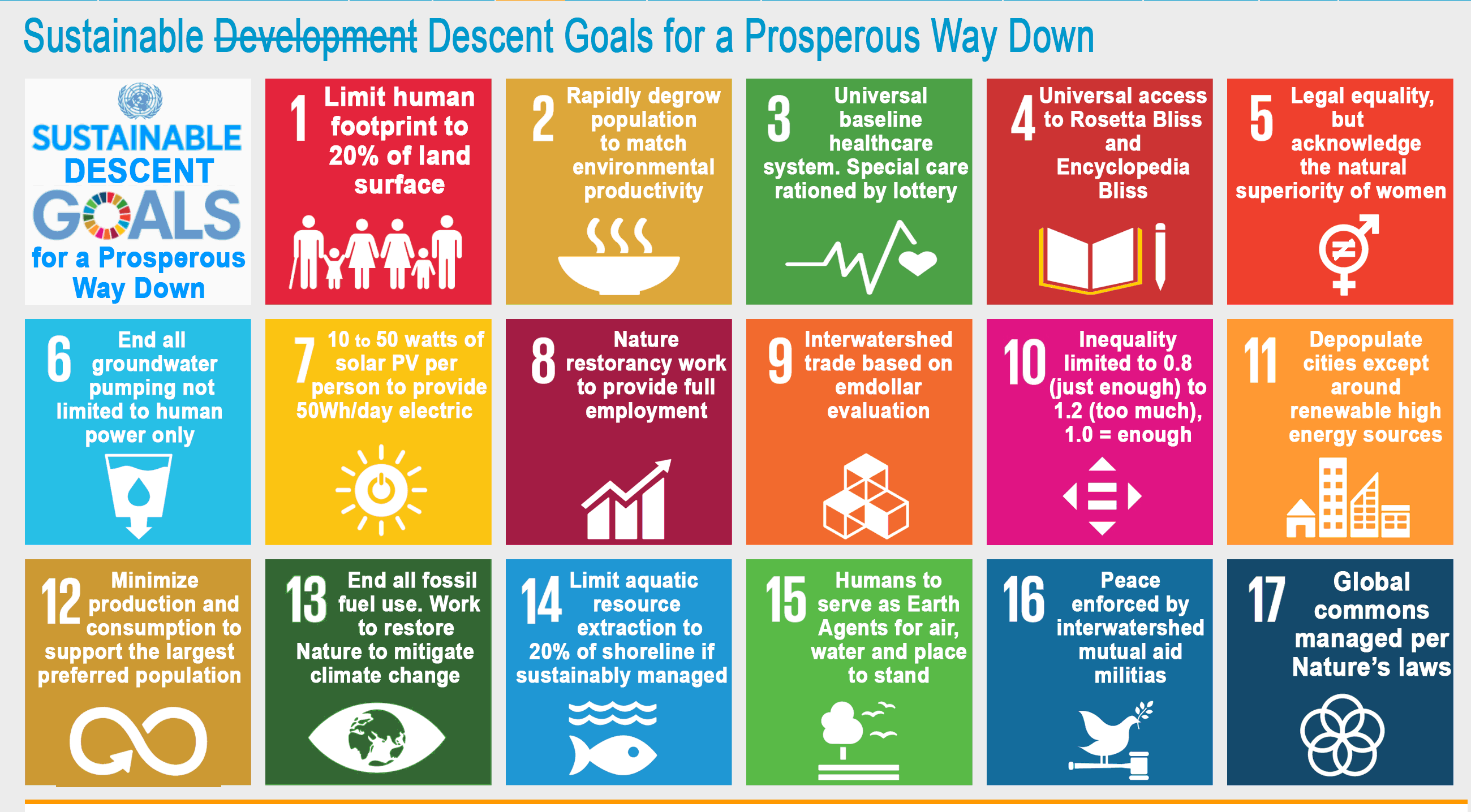
Adopting the above as goals might actually work to change the trajectory of modern techno-industrial society. But not to worry, none will or could be. Meanwhile the pace of planetary destruction will not slow. And then what?
179. If you could save the planet by killing half the world's population, would you?
Yes. Assume there is a button (perhaps provided by alien technologists) that, when pressed, causes 50% of all humans (and only humans) to drop dead in a nanosecond, wholly at random, with zero suffering apart from that of those remaining who mourn and would need to do something with the bodies. I would press the button knowing that I and everyone I knew had a 50:50 chance of dying.
The survivors would inherit 100 percent of current wealth and be twice as wealthy. In their enthusiasm to recover from their loss, they could easily growth the population at a mere 2%, replacing all who were lost, numerically, in only 35 years (similar to post-Black Death). And then what? To what end? Oh, back where we stated.
I likely sound anti-human, but modern techno-industrial humans (the 99%) are anti-planetary life-support system, aka Gaia, Nature, the biosphere we all (and posterity too) depend on. If we keep on keeping on, there will merely be more billions to die horribly during the chaotic descent phase of our overshoot and collapse to a possible extinction event (our own, not just those millions of species we have and are in the process of making go away secondary to our Anthropocene enthusiasm). You cannot be anti-planet and pro-human, but merely pro-humans of today and anti-posterity.
The problem of saving the world (or more literally the life-support system from ongoing destruction by unsustainable growth of humans x consumption) would not remotely be addressed by reducing the human population to 4 billion. To live within the carrying capacity of the planet we need to reduce the human population to a level that “can be supported indefinitely in a defined habitat without permanently damaging the ecosystem upon which it is dependent; the number of people, other living organisms, or crops that a region can support without environmental degradation.” Carrying Capacity and Overshoot

As a measure of our exceeding carrying capacity, of living “without permanently damaging the ecosystem… without environmental degradation” we need, among other things, to not cause species extinction nor could the human footprint prevent the evolution of new species to replace those whose extinction we (modern techno-industrial humans) are the cause of. What would a first-do-no-harm population of humans be? No one knows exactly, but 7 to 35 million is a best first guess. Carrying Capacity and Overshoot
So, before I pushed the button, I would gather a group of at least 256 others who agreed to push the button. To reduce the human population to be within long-term carrying capacity, I probably couldn’t push the button eight times as I would have a 50% chance of dying each time it is pressed. So 512 would be needed for there to be two left, by chance, to push it the eighth time,
But that wouldn’t work, because if the final population was 31,250,000, they could double every 35 years to put us back to where we are in 280 years or so. So what would be the point of enabling remaining humans to merely repeat the pattern? You could only expect a different pattern if humans change their narrative of human supremacy and learn to live properly with the planet.
So what might work is push the button once. Inform humanity why it was pushed (maybe lie and tell them Klaatu did it) and what changes need to be made, i.e. that the remaining population agrees to conduct a rapid (over a 50 year period) managed birth-off to avoid a die-off. Give the remaining 4 billion a year to agree to a rapid managed birth-off. Assume 1% agree. Push button again. Explain the situation again. There are 2 billion people and 12% agree. Condition not met. The ultimate “terrorists” whoever they are, wherever they are, lamentably push it again. Now two years have passed and the remaining 1 billion have more to think about during the coming year. A managed descent may be agreed to. Or not. Either way, the world is saved from human population x consumption.
We could seek out the condition now that will come anyway, and embrace descent with some enthusiasm in the near future to follow the green line option.
Or not.
180. Can you please commit to a sustainable Earth and contribute?
I can contribute to the sustainability debate, but not commit. Earth has managed to orbit Sol for about 4.5 billion years and is likely to keep doing so until subsumed by Sol as it goes Red Giant. That 36 percent of mammalian biomass is currently humans and 60 percent is our livestock, tells the story. This is not a condition that is sustainable, nor one I can commit to. Earth's Biomass
Some say we are presiding over the sixth mass extinction event, but I count nine including the one we are currently the cause of (i.e. it is anthropogenic). We have become a pathogen on the face of the earth. The ninth mass extinction may rival that of the Permian. Pathway to Humans
Whether life on Earth will continue, sustainably, is unknown, but likely in some form.
Will humans learn to understand the world system and learn to live with it properly to persist long term? This is unknown, but our current trajectory and history over the prior 12k years suggests not.
Past (to present) Lives of HumansThe evidence is that humans must keep on keeping on, despite possessing some foresight intelligence, because modern techno-industrial society selects for short-term self interest (short-termism) and against foresight intelligence. Sorry about that.
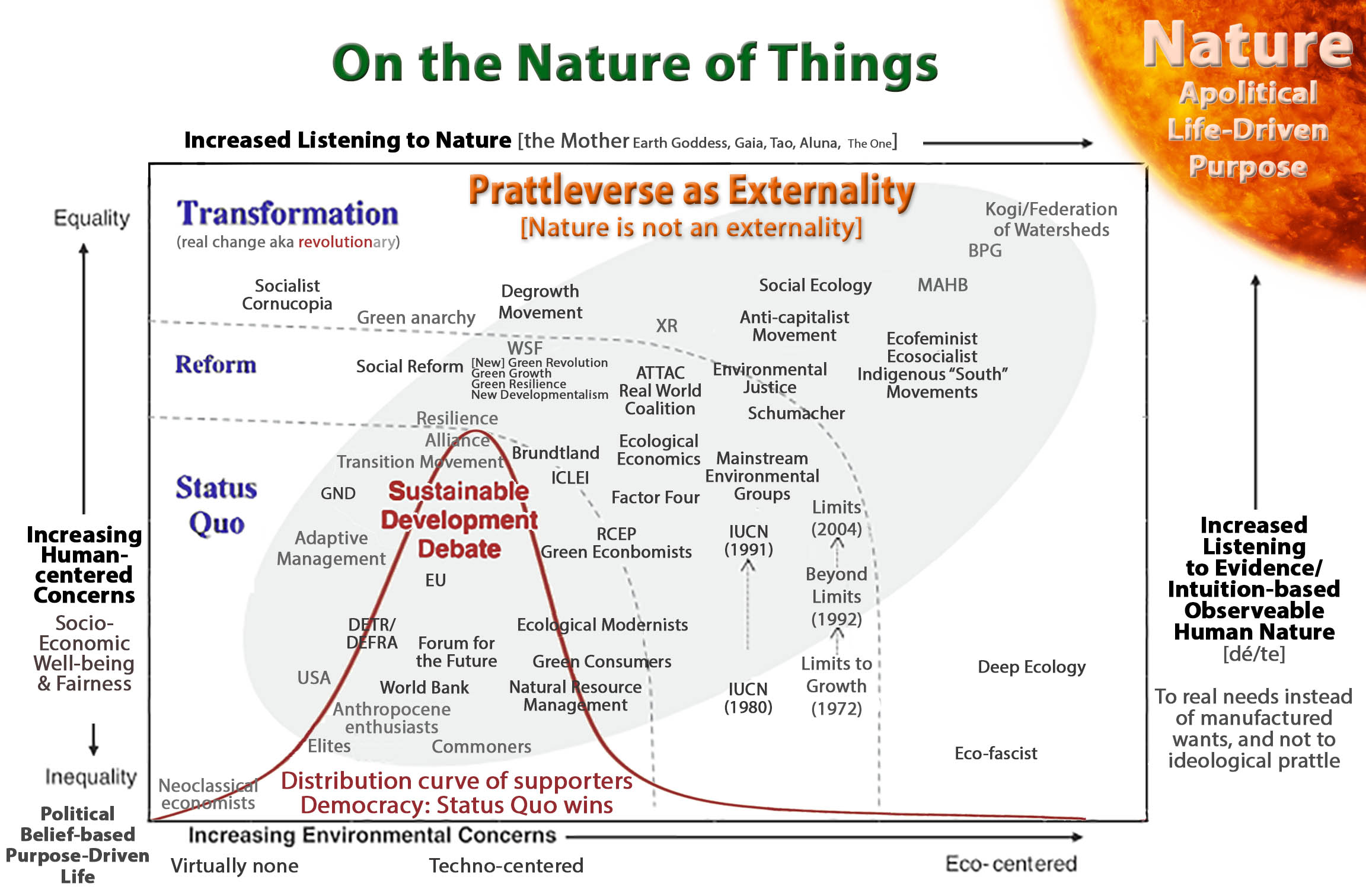
181. Is global environmental sustainability achievable under capitalism?
No, not remotely achievable. Capitalism was the best economic system for growing the global economy. When Nikita Khrushchev told the West, “We will bury you.” in 1956, he meant economically by growing Russia’s planned economy even faster. He was wrong and capitalism dominated the 20th century.
As we transition to climax and degrowth of the global political-economic system (involuntary), capitalism will no longer work. It could only work during a period of exponential competitive growth. Not growing, much less degrowing, is unthinkable within the NCE consensus. During descent conventional economists (products of some 22,000 colleges and universities that teach it as a required course) may meet to discuss how to make their country great again, but otherwise capitalism will be an atavism.
Theologians once held near supreme power in the pre-industrial agrarian economic system of serfdom based on a belief in the Divine Right of Kings (and their aristocracy) aka God's mandate. We still give Nobel Prizes in Economics (conventional NCE, not Ecological nor Biophysical economics) whose practitioners deeply believe in Growth's mandate.
Assume you are a systems ecologist and realize that global environmental sustainability over the coming millennia implies that humans are living under the carrying capacity of the bioregion they live in. This means their footprint is slight enough that they do not cause species extinction nor prevent the evolution of new species to replace those lost in the current mass extinction we of modern techno-industrial society, now global, are the cause of. No one knows exactly what the maximum human population would be to prevent extinctions and enable re-speciation, but the best-guess range is 7 to 35 million humans globally. Carrying Capacity and Overshoot
Ask yourself: how can capitalism or democracy achieve a rapid degrowth of human population and per capita consumption? That capitalism and democracy select for the opposite outcome is what is in front of your face as you travel about the planet by foot or virtually using Google Earth Timelapse.
To briefly state the human predicament:
• Our global economic system is NOT REMOTELY CLOSE TO SUSTAINABLE.
• We are captured and being dragged along by a complex, powerful and remorseless dynamic that automatically thwarts all attempts to stop it.
• If we don’t put time and energy into understanding it, we are doomed to go with it, right to the final curtain. Garvin Boyle
No one reading this, I’ll guess, likes this message, but this is what Nature is telling those who will listen. Denial will be water off Nature’s back. Nature doesn't care what we like or dislike, believe or disbelieve.

182. What are the root causes of environmental problems?
Rephrase the question to contain the answer:
What are the root causes of environmental problems affecting life on earth (not just humans), e.g. over a 1,000 fold increase in the rate of species extinctions (on a pathway towards a 10,000 fold increase by the end of the 21st century) in the latter part of the Anthropocene?

183. Despite many scientists' warnings that global warming is becoming irreversible, when will it really become 'too late'? Has anyone quantified when the point of no return will be?
We humans need to step back from what we think we know and consider the possibility that everything we deeply believe in and assert are social constructs. Those constructs that meet the needs of political and/or religious affiliation (i.e. tribalism including among experts/academics) always ignore scientists' warnings unless they happen to be viewed as supportive of consensus thinking.
Neither side of the political spectrum, nor those in the middle, will actually alter the trajectory of the dynamic we are all products of and serve (modern techno-industrial global monetary society) because they/we cannot. Maintaining the illusion that we can is one of many deeply held beliefs.
Science is also a narrative, an endeavor to tell the most likely stories, despite our biases, about the what-is, life, the universe, and everything. Over 60 percent of scientists identify as being on the left or right side of the political spectrum, i.e. they have a political identity and affiliation, and/or religious narratives that may limit what they can think. Most are specialists, experts, who know a lot about a little bit of the what-is. Very few are systems scientists or generalists who endeavor to connect all the dots of the specialists.
Virtually all scientists today work for money (and standing/social approbation) and whose bread they eat (or affiliate with), they tend to sing their song. There are scientists who don't, but identifying them and being able to listen to they who endeavor to listen to Nature is a skill not taught (except by a few) within the halls of higher learning.
As a social construct serving tribal narratives, science is severely constrained by evidence and reason. Claims can, and often are, not supported by experiment, observation, data, and inconvenient findings that are challenging to interpret. All other pretend ways of knowing, of finding things out, are "not even wrong".

The dynamic we are is remorseless and we long ago blew past "too late" into overshoot. No one has, nor is there anyone to give them, the power to foundationally change the dynamic. The right-leaning can but double down on "Growth's mandate" and the left-leaning can promise a Green New Deal that will turn more coal into solar PV, but we of modern techno-industrial society will keep on keeping on. Sorry about that. Could some people effectively opt out of the dynamic? Could 0.01 percent? I don't know.
The vastly greater inconvenient mess we find ourselves in is that global warming/associated change is merely one stressor we are unable to effectively alter. Existential issues facing humankind today (based on systems ecology, Jared Diamond's list of 12 environmental issues, Calhoun's rats of NIMH, and the list of planetary boundaries):
- Energy longage of demand: Growth.
- Biodiversity loss, mass extinction (Impact, I=PAT).
- Oversized human/livestock/pet/crop populations (Population).
- Overconsumption of planetary life-support system and growing behavioral sink (Affluence).
- Fossil-fueled technology enabled industrial sprawl (Technology): deforestation, overcropping, urban overgrowth.
- Soil loss secondary to oversalinization, soil mining, and erosion rates exceeding soil formation rates.
- Overuse of freshwater resources: construction of dams, levees, jetties; unsustainable use for irrigation and any pumping which lowers a water table.
- Buildup of biotoxins in the environment, including nitrogen and phosphorus as biosphere toxins.
- Over-extraction of animal resources by human predators not living in a state of Nature (36% of mammalian biomass is humans and 60% is livestock).
- Effects of introduced species: human, animal, or plant on native biomes.
- Ocean acidification and plasticization.
- Effects of anthropogenic climate change—politicized, hence a distraction (from other issues of greater concern).
Climate change is topical because you can be firmly against it, or assert your certain belief in it and demand political solutions that require putting one's party in power. Meanwhile the pace of planetary destruction will not be slowed. Sorry about that.
Instead, think about our collective Impact, but don't look to social media or mainstream media for information. Don't expect to learn about the human predicament from the schooling system.
It is entirely possible to graduate with highest honors from a top university and know essentially nothing about overshoot, carrying capacity, or sustainability, even if you are a STEM major. The more inconvenient truth is that most people would rather believe than know. Those who would rather know than believe, who question everything, who reevaluate all values and assumptions, who are abelievers, are some fraction of one percent. This is true for denizens of Facebook echo chambers and most think tanks to which only PhDs who have written at least several books are invited. Carrying Capacity, Overshoot and Sustainability
Our collective inability to think about the possibility that there are or ever could be ‘too many people’ on the planet has a long history that goes up to the time I am typing this. Ouora is one source of evidence. There are several questions on human ‘over’ population with over a hundred answers. Pick all of them and spend some hours scanning the answers and sorting them into sets of essentially the same answer. Do it as a citizen science project. Instead of watching another movie or episode of whatever, do it.
Assume that most of those who answer questions on Quora think they know enough to have an opinion—not that they do, just think they do. So the data reflects the opinions of experts, whether academy vetted or not (as part of your study, note whether the answerer has a background in a field at all relevant to the question). Some people are more likely to know enough to have an opinion. For example, Richard Feynman is viewed pretty much by everyone who knows enough to do advanced physics as no ordinary genius. Feynman said, “Science is the belief in the ignorance of experts.”
Was he talking about self-accredited know nothing experts from the hood like me? No, he was talking about academy vetted experts like he worked with. My suggestion is that you listen to those who endeavor to listen to Nature who has all the answers. Then ask Nature questions and listen to the still small voice her data speaks. To be a bit more helpful, here’s a short, readable intro:
World scientists’ warning to humanity — Rex Weyler
Rex Weyler ends by noting: "As an ecologist, I feel compelled to ask myself: if the last 50 years of environmental action, research, warnings, meetings, legislation, regulation, and public awareness has proven insufficient, despite our victories, then what else do we need to do? That question, and an integrated, rigorous, serious answer, needs to be a central theme of the next decade of environmentalism."
The Fundamental Failure of Environmentalism — David Suzuki
On his 80th birthday scientist and environmental activist extraordinaire David Suzuki noted that despite some victories of the David Suzuki Foundation and other efforts by environmentalists over the decades, that meanwhile "the pace of planetary destruction has not slowed ". Maybe there are no political solutions. Maybe any "integrated, rigorous, serious answer" will be wholly outside humanity's (including political activists to full-on eco-fascist revolutionary environmentalist's) current Overton window of thinkable discourse—for a time—yet know that things change, "this too, shall pass away", so learn now while access to viable information is still out there.
And always vet the source first (e.g. Weyler, Suzuki and who, if anyone, is publishing them, media bias/fact checkers are your friend and so is Wikipedia if you understand its limitations and bias). ALL UNVETTED SOURCES ARE NOT. Could a source know more than you do? Maybe. If so, maybe resist letting screens distract you and consider that:
WE WERE WARNED
(longer list here)
Harrison Brown, The Challenge of Man's Future 1954
Aldous Huxley, TV Interview 1958
Population, Evolution & Birth Control 1964
A Collage of Controversial Readings [from Han Fei to Garrett Hardin]
A Blueprint for Survival 1972

Overshoot: The Ecological Basis for Revolutionary Change 1980
A Planet for the Taking 1985
An Appeal for Joint Commitment in Science and Religion 1990
Elder Brothers' Warning 1990
World Scientists' Warning to Humanity 1992
Joint statement by fifty-eight of the world's scientific academies 1993
The Anthropocene: conceptual and historical perspectives 2011
Aluna: Elder Brothers' Second Warning 2012
Consensus Statement from Global Scientists 2013
World Scientists’ Warning to Humanity: A Second Notice 2017
Worsening Worldwide Land Degradation Now ‘Critical’ 2018
Living Planet Report of 59 global scientists & overview 2019
The State of the World's Biodiversity for Food and Agriculture 2019
Nature’s Dangerous Decline ‘Unprecedented’ (IPBES) 2019
World Scientists’ Warning of a Climate Emergency 2019
A Discussion and Call to Action on Global Catastrophic Risks 2020
(38 in roundtable, Part 1: Warning. Part 2 and 3: no 'real solutions' considered as consensus limits thinking.)
Wildlife in 'catastrophic decline' due to human destruction, scientists warn 2020
Limits to Growth Updated 2020
International Scholars Warning on Societal Disruption and Collapse 2020
Underestimating the Challenges of Avoiding a Ghastly Future 2021
Freshwater fish in 'catastrophic' decline 2021 BBC summary
FINAL REPORT- Delivering the Human Future 2021 No real solutions
(The world needs a ‘survival revolution’ on a scale far larger than the ‘industrial revolution’)
Global Trends 2040 (2020 may look like the good old days) 2021

Note:
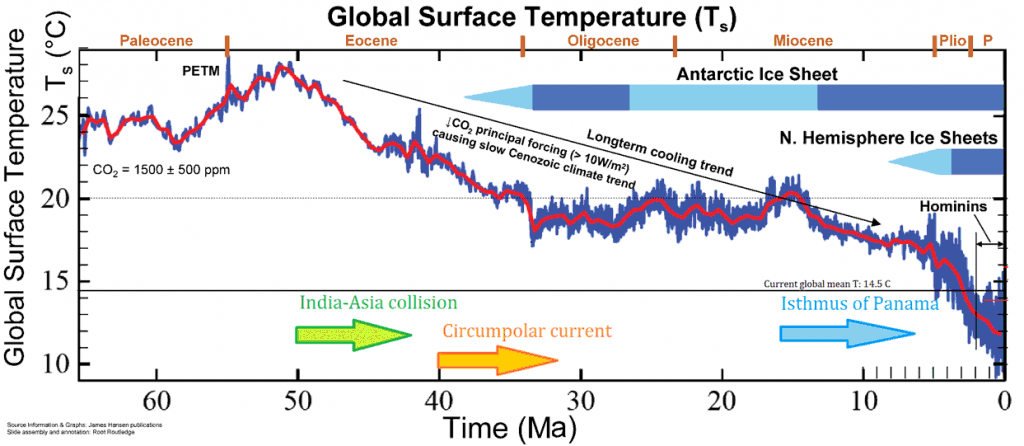
It has been warmer, but the rate of change is the bigger issue.
My upvoter, James Matkin, used the following graphic, which is not from New Scientist. It appears to be a mangled misinterpretation of a chart showing delta T, the change in temperature, climate sensitivity, not the average global temperature. Some amateur climate experts may have forgotten their calculus.
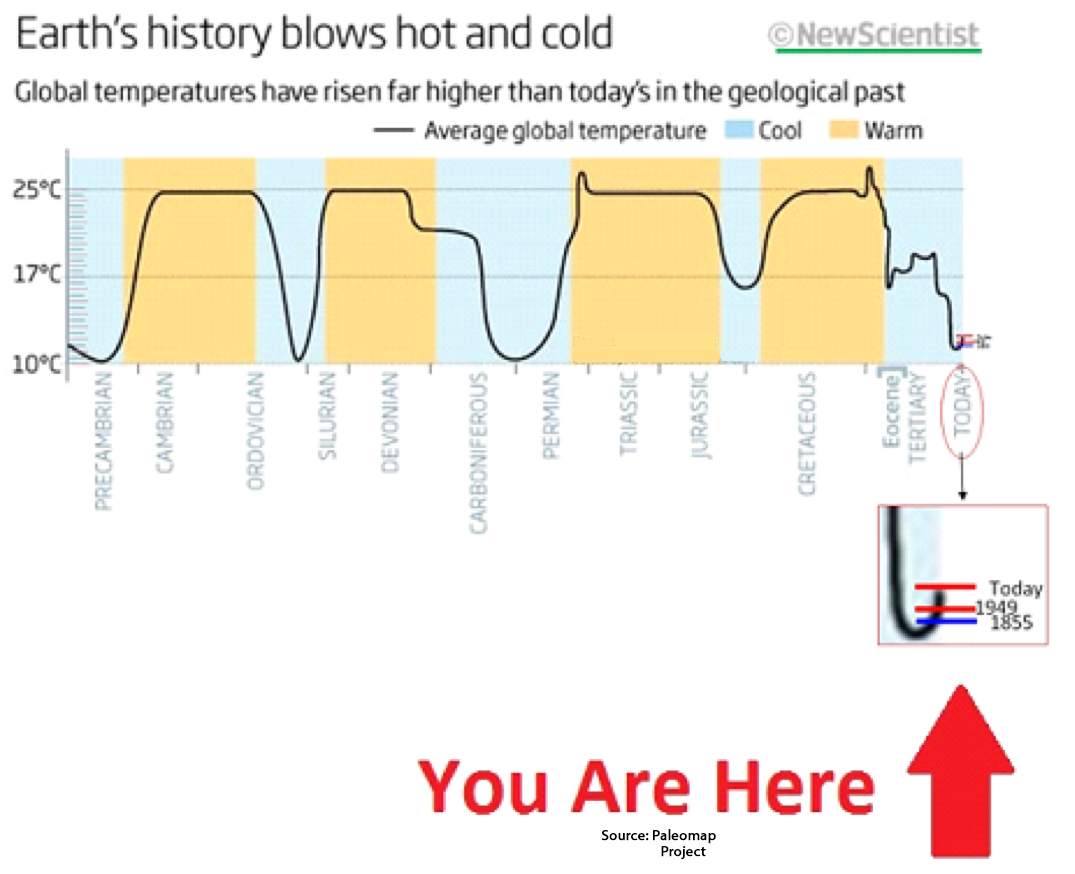
Maybe this is why Shakespeare suggested we first kill all the lawyers. A more evidence view of the past:
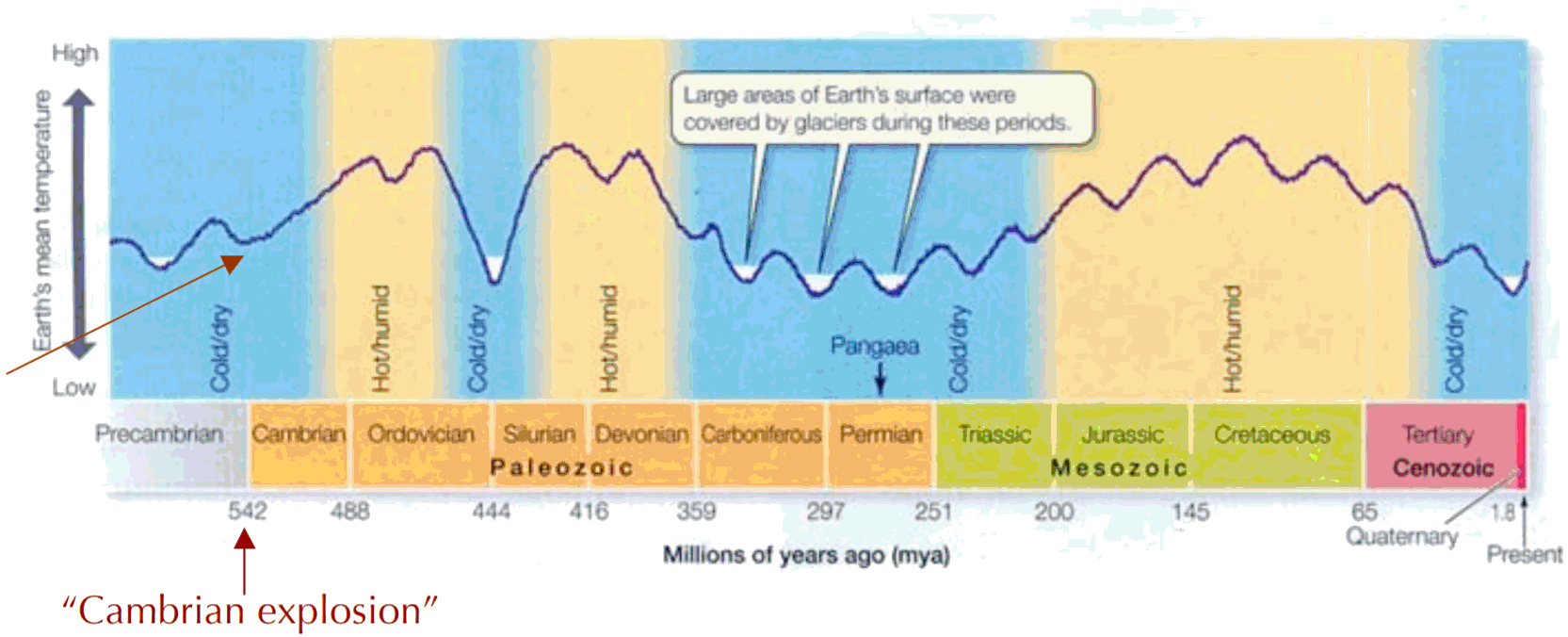
184. Without the restriction of the birth rate, is our planet threatened by an ecological catastrophe?
"Can you think of any problem in any area of human endeavor on any scale, from microscopic to global, whose long-term solution is in any demonstrable way aided, assisted, or advanced by further increases in population, locally, nationally, or globally?" —Al Bartlett
https://en.wikipedia.org/wiki/Albert_Allen_BartlettIn 1949, Aldo Leopold noted: “One of the penalties of an ecological education is that one lives alone in a world of wounds. Much of the damage inflicted on land is quite invisible to laymen. An ecologist must either harden his shell and make believe that the consequences of science are none of his business, or he must be the doctor who sees the marks of death in a community that believes itself well and does not want to be told otherwise.”
Today, however, things are much different. Today the penalty of an ecolate (systems science literate) education is that one lives alone in a world that is in the ICU facing multiple system failures that are quite invisible to all leaders including thought leaders (those who think they are educated) in the media (now dominated by social media) and most of those (the 99+%) teaching in universities. Sorry about that.
If the damage of the Anthropocene were visible, is visible to you, or vastly worse—foreseeable, then any would-be doctor to Gaia would call for a radical restriction in birth rate (e.g. 1:140 to 1:200 women who want to can give birth per year initially to transition to 2.1:1 woman births in 50 years) to merely mitigate the ecological catastrophe we are presiding over (i.e. the greatest mass extinction event since the late Cretaceous that could rival that of the Permian).
We, of course, just want what’s best for the most people, so destroying a planetary life-support system and collapsing our modern techno-industrial (now global) society is not only unintended, but wholly unthinkable, unbelievable, and so no thought leaders can nor will think/believe that any such thing as has happened to all prior complex societies could happen to ours.
So nothing to worry about. It’s all good. Get good grades. Make lots of money. Just keep on keeping on helping to grow the economy, stupid.

185. Will humans exist as a part of biodiversity within the limits of resources of the planet?
Not all humans are products of and serve modern techno-industrial society, but 99+% are and do. Some fraction of a percent of humans may actually be citizens in good standing as members of the biosphere who do not contribute, directly or indirectly, to species extinction, to the Anthropocene, to the greatest mass extinction event since the late Cretaceous that could rival that of the Permian.
 The environmental resources of the planet are limited and are being rapidly degraded. When we modern techno-industrial humans can no longer turn fossil fuels into food faster than growth in population x per capita consumption demands, our complex society will climax and descend, likely into conflict that will increase scarcity, inducing more conflict/chaos in a downward death spiral as usual. Sorry about that.
The environmental resources of the planet are limited and are being rapidly degraded. When we modern techno-industrial humans can no longer turn fossil fuels into food faster than growth in population x per capita consumption demands, our complex society will climax and descend, likely into conflict that will increase scarcity, inducing more conflict/chaos in a downward death spiral as usual. Sorry about that.
If humans could foresee the outcome of their growth dynamic, they would agree to a rapid birth-off to avoid a die-off and to transition to a world where humans caused no species extinctions nor prevented new species from evolving to restore biodiversity to pre-Anthropocene levels in 10–20 million years. This would involve a 50 year transition where initially one woman in 200 who wanted to could give birth the first year, to on average 2.1 women needing to give birth each year after 50 years to maintain a global human population within a range of about 7 to 35 million.
A birth-off is alternative to a Malthusian die-off. If we could choose, a managed birth-off has the added plus of allowing most if not all of the information humans have acquired over the last few millennia to be passed on, and for a few literate, numerate, and ecolate humans to be the remnant population instead of those having the most ammo in their bug-out bunker or of the remnant zombie hordes should those with the ammo run out.
Carrying Capacity and Overshoot
Of course 99+% of modern techno-industrialized humans couldn’t and wouldn’t agree to a managed descent, so sorry about that. If you have the short-term misfortune of having a bit of foresight intelligence, consider voting with your feet to abandon the ship of state, the state of living in and serving modern techno-industrial society.
186. What is the most underrated civilization in history?
The Tairona, a Pre-Columbian civilization in the region of NE Colombia who traded with the Aztecs and Maya. As Tairona 3 phase, they did away with elite material privelage, military or economic empire building, and monument building to serve elite interests at the expense of commoners. They lived in harmony with Nature without seeking conquest of environmental resources nor other people, i.e. they lived sustainably in peace despite being a complex society.
- 5900 BP: Region inhabited by bands of matriarchal hunter-gatherers.
- 3150 BP: Agriculture, cultivation of maize, begins mixed with continued hunting and gathering.
- 2150 BP: Relatively dense occupation of the region but without conspicuous elite privilege and empire-building.
- 1900 BP: Beginnings of complex Tairona civilization. Population increases as agriculture becomes more widespread and intense; robust local trade networks emerge.
- 1650 - 1450 BP, Tairona 1 phase: 200 years, goldwork extensive, elaborate pottery, ornaments not limited to elites, but elites lord over commoners, at least in moderation, using threat of force with support of religious elites. Early empire-building becomes evident. As usual, elite interests lead to overtaxing production in outlying areas by exploiting both commoners and environment, stressing environment and commoners, leading to environmental overshoot and descent with or without revolt.
- 1450 - 1050 BP, Tairona 2 phase: 400 years. Descent is followed by slow environmental recovery. Significant local variations indicate tolerance of diversity. The religious elites align with the commoners and come to lord over the chiefs, those who would use force, had used it, and had gone too far. Elite personal privilege decreases. The priests, the religious class, are social/intellectual elites who live as the commoners and come to no longer serve the aristocratic elites whose power is based on military threat. They work to serve their own elite interests and lord over the commoners by constructing empires of belief. Monument building is limited to ceremonial sites. Their empire spanned multiple chieftainships and they were able to enforce regional peace. Peaceful development maximizing human interests, however, lead to over-development, to overshooting the environmental carrying capacity, to peak population, and to forced descent.
- 1050 - 300 BP: Tairona 3 phase, 750 years. Some had warned the priests and commoners that their way of life was unsustainable. After climax, during descent, some intellectuals lead an internal coup to replace the priesthood. They retained some trappings of religion as it was the conceptual language the commoners understood, but their focus was on the here and now environment that must be placed above short-term human centered self interests. A hierarchical network of villages develop. Trade increases as does the population of the entire region during the recovery phase, but it is managed to remain well within carrying capacity. The mámas are the governors, the educated elite (mámas train for 18 years), whose attention to detail, to serving Aluna, the life-support system (environment), worked to enable prosperity within limits, the pax máma. They had learned the hard way but they learned to avoid their predecessor's mistakes. They put environment above human interest. They do not speak of going to another world. They live in this one, right and well, guided by what actually works. They tell the commoners there is "another world," a conceptual world commoners know little of, lines of thought that the mámas travel. They work only to serve the Mother (environment) and help the commoners live right and well within limits; limits to population growth, per capita consumption, and limiting resource exploitation to protect environmental resources from human demands. Peace becomes the norm. Without distant elites making demands, the mámas guide local settlements to take care of their environment. Population is adjusted to long-term carrying capacity. Thus no empire-building based on force or threat of force develops. Most Taironans live in the lower elevations along the cost, the lowland Taironans who also fish and harvest sea salt. The upland Taironans grow different foods and trade cotton, living in the Heart of the World where the most accomplished mámas studied and taught.
- 300 BP to present: A remnant of the Tairona 3 phase persisted 1100 years to the present. They tried twice (1990 and 2011) to teach us what we need to know to live long and prosper within limits. But we have yet to listen.
We can learn about real solutions from these people
This is what a non-monument building Taironan city looks like.
187. What is something that made you question reality?
Short answer: my fellow humans; who are the storytelling animal. Maybe corvids or cetaceans tell stories, but we don’t know. Honeybees tell stories of where to find nectar, so we are not alone in telling stories, but we are the only animal that habitually tells stories that are not true.
Indeed, we tell no true stories as we believe our stories about things ARE true. We tell stories about what we imagine or guess to be real true reality, the what-is. We mistake the stories, descriptions, concepts, models, narratives… about the what’s out there—we confuse what our primate brains can envision is out there—for the what may be out there. But we are no more able to think true thoughts than a dog is of understanding calculus.
Some scientists go to great lengths to tell likely stories by endeavoring to falsify every story they can think of to see what stories, if any, are left. But normal humans would rather believe than know anything other than that they are right, absolutely right and can’t be wrong about cherished and deeply held beliefs, which excludes having even the slightest grasp of reality.
Most of the time we can walk about or drive without bumping into things, but otherwise there is no evidence the world in our heads is real. We think we wake up in the morning, “decide” (free will) to get out of bed, eat, “gotta go…, gotta do…, I should… and then I’ll be happy, but I’d better…”.
That one’s entire narrative of self and other, of self and human centrality, is a social construct of a tribal ape who, as a modern techno-industrialized (fully or partially) urbanized human who doesn’t live in a kinship group of 20–50 others (range 5–85) based on utter trust, equitable sharing and cooperation, but lives in a complex dissipative overdensity society where most interactions are non-repeating or even real (are screen to screen, image to image) is our pathetic lives. Or not.
We moderns seek out surrogate pseudo-tribes in echo chambers based on shared narratives (error, ignorance, illusion), especially political and religious culturally normative cliques. Our minds cling to our image of the world we regard as real only because of our ignorance.
Pick any two humans at random. They will tell stories that are wholly or in part incompatible such that both can’t be right (though both could be wrong as usual).
My only certainty, apart from tautological claims, is that I know absolutely nothing (for sure). That is the something that makes me question everything and to endeavor to rethink everything, to doubt all assumptions, to reevaluate all values, and embrace the humility of not knowing.
Everything I think is at least in part in error. And I could be wrong about everything. The more advanced my education, the more I realize the vast limits of my knowledge, the vast extent of my ignorance and error. Most, more likely all, of what I think I actually know is an illusion.
As a modernized primate I seek consensus as substitute for affiliation, for membership in a functional social group, a band of sisters (or perhaps brothers). Biologically my brain is wired to regard the withdrawal of social approbation (e.g. consensus) as an existential threat, as banishment or exile would have been on the African veldt.
But for some reason I’d rather know than believe, so I question all claims: the claims of the living and dead, of putative prophets and knaves. I don’t believe any stories others tell nor such stories as my brain offers.
To perhaps iterate towards sanity, fearlessly subject all stories to the flames of an all consuming doubt, and see what is left over. Then perhaps consider the possibility a story might not go away just because you don’t like it.
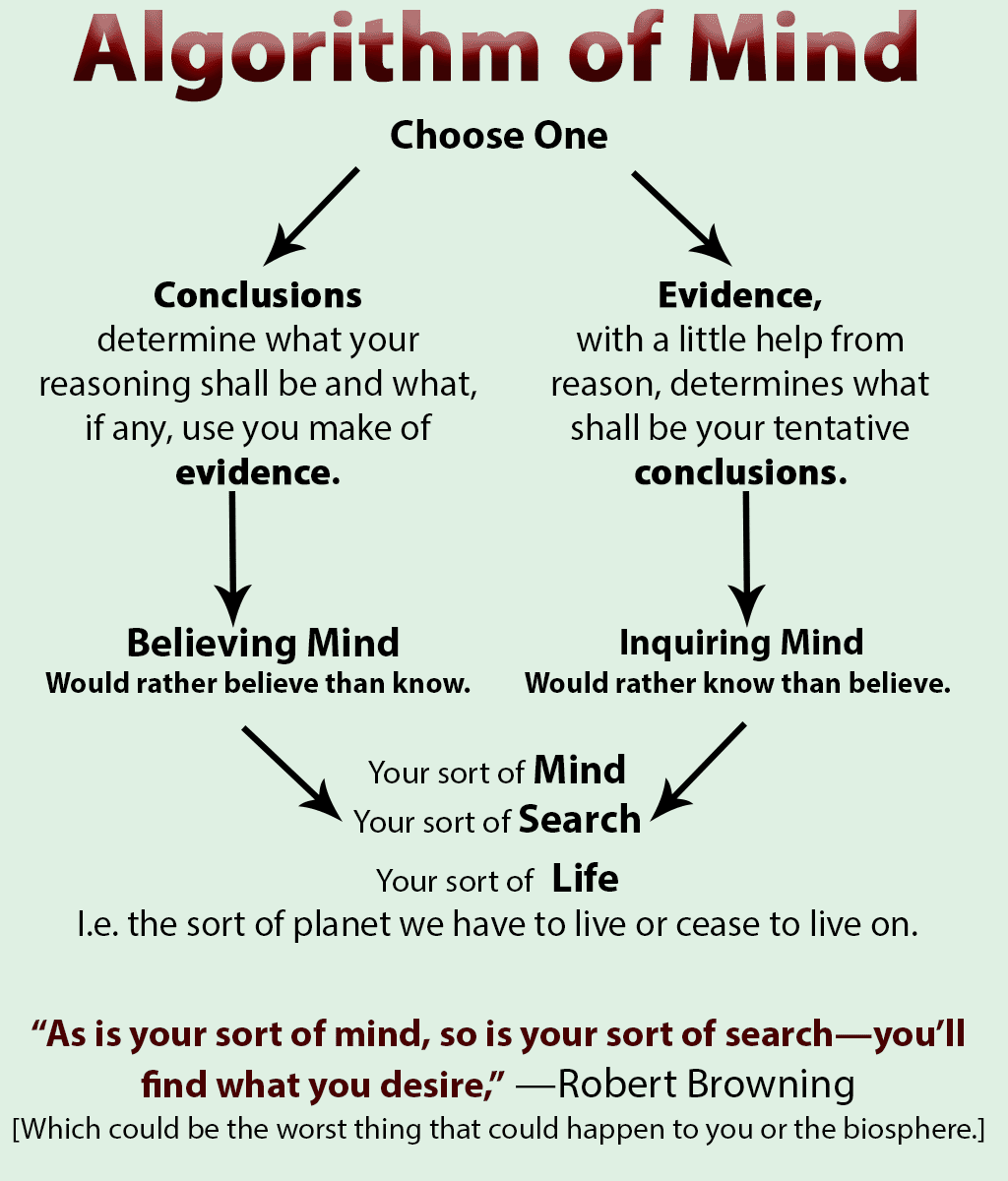
188. With the speed of deforestation and world population, should we worry that in the next decade there will be no land animals living in the wild?
In the next decade there is likely to be some insects, even a few mammals, still living in the wild. Of concern is the trajectory, the trend, the mass extinction event we are presiding over. Modern techno-industrial humans are currently causing over a 1,000 fold increase in the rate of species extinctions on a pathway towards causing a 10,000 fold increase by the end of the 21st century. The current anthropogenic mass extinction event could exceed that of the Permian. Humans exceeded carrying capacity, began causing species extinctions, long before modern times (1450-present).
And if we deforest a region and replant it, typically in one species giving the highest return on investment, we are not reforesting, we are turning forest biomes into tree farms. We don't eat the trees, so the land is not considered agricultural, but it is. Agriculture is the number one driver of species extinction (global warming may become, but isn't yet).
In southern Oregon where I currently live, the Pacific Northwest Bioregion is mostly a tree farm and has been for over a century with other areas being pasture and croplands. I know one place, Golden and Silver Falls, where a few old-growth Douglas Fir can be seen because it was not economical to harvest them when the 45 acres were "given" to the state to develop as a recreational park in return for building roads to allow further clear-cutting back in the 1930.s at public expense.

Currently some 4 percent of mammalian biomass is "wild" or still living in human recreational areas. Actually the 4 percent includes marine mammals, so on land, only about 2 percent are "wild". Earth's Biomass: Species extinction is one measure of Anthropocene progress, but biomass change is another.
 Should you be concerned or worried? If you are a neoclassical economist or Anthropocene enthusiast (among the 99+%), of course not. It's all good. Wildlife living in managed parks where people can enjoy them will have a much better life than those living in the wild having to eat each other. And humans living in huts will be saved from their meaningless existence without cars, supermarkets, or even smartphones.
Should you be concerned or worried? If you are a neoclassical economist or Anthropocene enthusiast (among the 99+%), of course not. It's all good. Wildlife living in managed parks where people can enjoy them will have a much better life than those living in the wild having to eat each other. And humans living in huts will be saved from their meaningless existence without cars, supermarkets, or even smartphones.

189. What is humanity’s biggest problem?
Not knowing that "The greatest shortcoming of the human race is our inability to understand the exponential function." Al Bartlett - Wikipedia
Our modern techno-industrial society selects for short-term self interest. Humans have some capacity for foresight intelligence, but it has been and is strongly selected against in modern times (1450 to present). We, therefore, are collectively unable to foresee the coming bottleneck that some humans may pass through.
So our biggest problem will be to successfully pass on information packages, including some literate, numerate, and ecolate humans, to transition to a viable ecological civilization that is actually sustainable. Our biggest current problem, therefore, is that we lack foresight intelligence.
"If society does not succeed in changing attitudes and institutions for a harmonious descent, the alternative is to prepare information packages for the contingency of restart after crashing..., seek out the condition now that will come anyway." —H.T. Odum
Figure 1 A. Generalized world model of man and nature based on one-shot fossil fuel usages and steady solar work. Pathways are flows of energy from outside source (circle) through interactions (pointed blocks marked 'X' to show multiplier action) to final dispersion of dispersed heat. The tank symbol refers to storage. Here world fuel reserve storage helps build a storage of structure of man's buildings, information, population, and culture.
190. When will the human population exceed the carrying capacity of the planet and how much stress is the environment currently experiencing because of the continuing growth in the numbers of people?
It is entirely possible to graduate with highest honors from a top university and know essentially nothing about overshoot, carrying capacity, or sustainability (i.e. to be inecolate), even if you are a STEM major. The more inconvenient truth is that most people would rather believe than know. Those who would rather know than believe, who question everything, who reevaluate all values and assumptions, who are abelievers, are some fraction of one percent. This is true for denizens of Facebook echo chambers and most think tanks to which only PhDs who have written at least several books are invited.
Carrying capacity: the population of a given species that can be supported indefinitely in a defined habitat without permanently damaging the ecosystem upon which it is dependent; the number of people, other living organisms, or crops that a region can support without environmental degradation.
When a species exceeds carrying capacity it causes permanent damage to the biome it depends upon, whether a small watershed area or planet Earth. When a species' footprint causes the extinction of other species, that impact is permanent and involves environmental degradation. So one measure of ‘degradation’ is 'causing species extinction' which is objectively measurable.
We are currently presiding over the greatest mass extinction event since the late Cretaceous, one that may rival the Permian. When did excessive impact begin? We regionally exceeded carrying capacity when we became a technology-using invasive species spreading beyond the African savannas in which we evolved (and the megafauna co-evolved with us). The rate of anthropogenic species extinction is now over a 1,000 fold increase over baseline, heading towards a 10,000 fold increase by the end of this century. Humans exceeded carrying capacity when the population of our Anthropocene enthusiast ancestors (regionally causing megafauna extinctions on five continents) exceeded a few million.
Boil it down: we started to exceed carrying capacity regionally tens of thousands of years ago when technology (e.g. fire, Clovis point and atlatl tech) enabled us to become an invasive species on five continents. We collectively exceeded the maximum sustainable population compatible with not causing species extinction when our population exceeded a best guess range of 7 to 35 million. See Carrying Capacity, Overshoot and Sustainability.
So, the question is not ‘when will’, but when did we. Well, sometime after most humans were practicing unsustainable agriculture on too large a scale to build empires to serve elite interests, when most humans were no longer hunter-gatherers or forager-low-intensity-farmer-gardeners, but were elites or commoners. We began to pulse into overshoot about 10k years ago and most humans were repeating the pattern 3k-4k years ago regionally as unsustainable empire builders.
Then about 300 years ago, fueled by a planetary larder of fossil fuels, we pulsed globally into what will be called the Euro-Sino Empire that started with the Industrial Revolution in the Euro region, briefly passed the torch to the Americo region in the 20th century, and will climax globally during the Sino phase of modern techno-industrial monetary society.
Enjoy the overpulse while you can as the pattern always climaxes followed by descent, not infrequently to near total dissolution, leaving only ruins. Or not. You can believe anything you want, for a time, but it won’t change our trajectory.

191. The world population has been exponentially increasing at an incredible rate within the last century. Will humans be forced to deforest animals' natural habitats for agriculture and housing in the near future?
Prior to the advent of agriculture, about 8.8 billion ha of Earth’s land surface was old-growth forest, except where recovering from fires or other destruction. There are now about 1,1 billion ha of primary forest left plus another 3.9 billion ha of areas of repeatedly deforested land, most of which may look like forest when flying over it, but are actually tree farms that have been logged repeatedly and often replanted in one species that will provide the greatest return on investment the next time the “forest” is cut down.
Tree farms are not forests, but should be considered a type of agricultural land even though food (from pasture, range, crops, orchards) is not grown. A tree farm may look more natural than a broccoli field, but that is an illusion most modern techno-industrialized humans fail to notice.
Thanks to Google Earth’s Timelapse feature, you can see that what we still call forests are about as natural as a cattle pasture. Click to view animated gif of tree farming in Oregon where each section is clear-cut every 40–60 years. Elsewhere vast areas are being turned into plantations, pasture, orchards, and cropland. All remaining forests could be reduced to remnant areas for human recreational use and lumber production by 2050.
There is no “will humans be forced to” do what we’ve been doing and are doing. In the last 60 years of scientists’ warnings, the pace of planetary destruction has not slowed. Expect humans to keep on keeping on until they can’t.

Growth may seem normal, and for a time is for a metastasizing cancer, but growth is not remotely sustainable nor normal even if conventional economists attempt to normalize it and deeply believe in what they are doing.

192. Should the U.N. or W.H.O. have a "hit list" of species, such as human or animal parasites, disease vectors, or disease-causing species, which should be driven into extinction? What species would you nominate for this list?
The question is utterly human centric. I was looking to see if anyone had mentioned the obvious. We are presiding over the greatest mass extinction event since the late Cretaceous that could rival that of the Permian. Modern techno-industrialized humans are currently causing over a 1,000 fold increase in the rate of species extinctions on a pathway towards causing a 10,000 fold increase by the end of the 21st century. Humans exceeded carrying capacity, began causing species extinctions, long before modern times (1450-present). From the POV of all organisms on the planet, with the possible exception of some pets, livestock and crops, there is only one species on the list.

193. Many problems currently faced comes from the need to feed the growing population in an increasingly higher standard of living, instead of targeting supply, why not somehow lower the population so everyone can be supplied comfortably and sustainably?
"The greatest shortcoming of the human race is our inability to understand the exponential function…. Can you think of any problem in any area of human endeavor on any scale, from microscopic to global, whose long-term solution is in any demonstrable way aided, assisted, or advanced by further increases in population, locally, nationally, or globally?" —Al Bartlett - Wikipedia
During the last 300 years of economic growth, people have been misinformed that all problems are basically a shortage of supply problem that is temporary, that the economy will fix, and the fix is more growth. We are not, however, suffering from a shortage of supply, but a longage of demand.
This seems like an okay condition as fossil fueled economic growth has been faster, for a time, than population growth. We have been, for a time, able to turn fossil fuels into food faster than Malthus thought in 1798 was possible, or the Ehrlichs in 1968. Sadly, the deeply held belief that they and the Meadows and all those other doomers have been proven wrong by continued growth is a consensus delusion. Gaia 'believes' in feedback delays in complex systems, and doesn’t care what humans believe.
About 90 percent of the energy, the mostly processed food on the end of your fork that on average traveled (by truck, train, cargo ship, plane) 1,500 miles to get there, is from fossil fuels, direct (e.g. diesel to run ag equipment) and indirect (e.g. natural gas to make nitrogen fertilizers). Knowing how to turn fossil fuel into food more efficiently will not butter your bread, if any, without industrial inputs into the agricultural, processing, and transportation/distribution systems.
Sadly, the average teacher or professor, and those they teach, if asked where food comes from will soon indicate they haven’t the slightest idea where 90 percent comes from. Food comes from the supermarket and fields, vertical farms, or something.
 I happen to be a trained agronomist with degrees in crop and soil science, so I may know more than most professors do about where food comes from, but I’m not an expert. Yet I’m not clueless, either. Fossil fuel inputs into our industrialized food production system are not remotely sustainable. Food production will climax and descend, likely this century, and sorry about that.
I happen to be a trained agronomist with degrees in crop and soil science, so I may know more than most professors do about where food comes from, but I’m not an expert. Yet I’m not clueless, either. Fossil fuel inputs into our industrialized food production system are not remotely sustainable. Food production will climax and descend, likely this century, and sorry about that.
The only thing we could do would be to embrace a managed descent, including a rapid birth-off to mitigate any die-off, and learn to know our needs from our wants to minimize wants and focus on needs during the transition. But we won’t and can’t because we will keep on keeping on and double down on our belief in growth until we can’t. “People would rather beilieve than know.” — E.O. Wilson. Sorry about that in advance.
Consider one food item, corn:

Without fossil fuel inputs, production will decline to less than pre-industrialized levels secondary to extensive soil mining and erosion of topsoil down to parent material. Soil will take hundreds to thousands of years to recover as will other systems whose environmental productivity has been degraded (e.g. aquifers, forests, oceans and climate)
We have come, in recent decades, to normalize growth, which has not been the norm for us or any species as the millennia pass. Even a growth rate of 0.00001% is unsustainable. As with a metastatic cancer, grow can only be for a time, and if at the expense of the system (e.g. an organism) that the growth dynamic is a subsystem of (e.g. cancer), the system and its subsystem will be degraded or terminated.
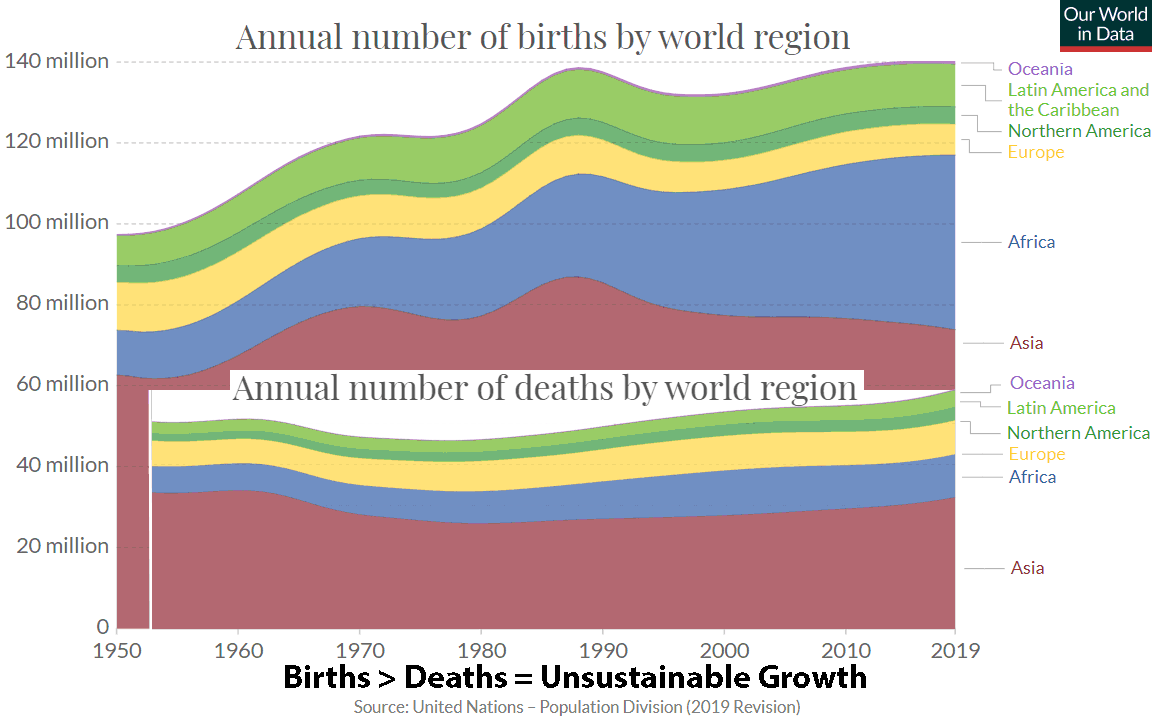
The growth that modern techno-industrialized humans celebrate and deeply believe in will climax and descend, i.e. deaths will exceed births. Extinction is one allowed outcome. So is transitioning to a steady-state biophysical economy of enough for a vastly smaller population of humans, crops, pets, and livestock well under the carrying capacity of the biosphere’s biomes (so as to leave room for Nature), than anyone who is deemed an expert today can envision (or admit to). But Nature doesn’t care.
I consider myself an extreme cornucopian optimist living on an abundant Earth. Could humans come to understand the planet and learn to live with it properly? Yes, as doing so would not violate any laws of the universe. This will involve foundational change, a recovery of foresight intelligence, and, yes, those transitioning through the coming bottleneck will find doing so lamentable as usual. We may well lose all information as no literate, numerate, nor ecolate humans may inherit the rubble.
Or maybe some will form pockets of viability that work, preserve information packages, and humans will become naturcentric again. They will live long (as a species) and prosper in their sapience.
Will we go extinct this time around? Will some remain to merely keep on repeating the pattern of empire building, of overshoot and collapse, until our extinction ends the pattern? Will we learn to love, understand, and live properly with the planet? I don’t know, but as a fideist I believe we can and so I have a life-driven purpose to work unto my last breath towards our persistence as responsible, non-pathological members of Earth’s life-support system, the ecos.

194. Should the world adopt a single child policy for couples to allow the world to become sustainable again, given this would continue diversity as it was worldwide?
To become sustainable again, given that our experiments in complex society have almost been a universal failure (with perhaps one exception, all prior ones collapsed or ‘faded away’) is the prize we should be keeping our eyes on. Success, however, will involve far more than enacting a global one-child policy and enforcing it universally. Failure to enforce would select for any groups who failed, intentionally or not, to eventually become the majority as those who complied would in effect self-selected out of posterity. If this is not obvious, read Exploring New Ethics for Survival: The Voyage of the Spaceship Beagle by Garrett Hardin
Implementing and enforcing a one-child policy would have to be time limited as once the sustainable population is reached, a 2.1 child on average policy would be needed. Better to start with a one child per 140 women and transition to a two child policy in fifty years.
The other problem is that a one-child policy that is 100 percent implemented would not degrow the population nearly fast enough. But again, transitioning to a sustainable population size while failing to meet the other requirements, such as a sustainable level of per capita consumption of only renewable resources, will have the same outcome, i.e. failure to persist long term as a species as the millennia pass.
Modern techno-industrialized humans have vastly decreased biodiversity recently by presiding over an anthropogenic mass extinction event that could exceed that of the Permian. Human expansionism is currently causing over a 1,000 fold increase in the rate of species extinctions on a pathway towards causing a 10,000 fold increase by the end of the 21st century. This is not remotely sustainable.
To stop the species extinctions and leave room for new species to evolve (to replace the loss of biodiversity) requires a vast and rapid decrease in livestock, crops, pet, and human populations.
We are nearing a climax in human population growth, and most people think the Earth could easily support far more humans forever and ever because that is what the experts the UN deems to consider are telling them.
Others recognize that growth cannot be illimitable, but believe humans will and are transitioning to a steady-state condition in which billions of humans will do as well or better than the upper-middle class do now.
There will be challenges, equality and social justice issues, but humans are clever apes and will overcome all challenges. Or not.
195. In the last two hundred years, the human population has grown much, much faster than at any other time in world history. What factors have led to this increase in the rate of growth?
Ten thousand years ago, before significant development of agriculture, our hunter-gatherer nomad ancestors numbered perhaps 5 million, and by 3,000 years ago the number of humans had increased ten-fold to 50 million. The factor was agriculture, a way of diverting much more environmental productivity to humans and livestock. Agriculture, food energy, enabled about a ten-fold increase in population.
There was about a billion humans 200 years ago. Agriculture had spread around the world, and agrarians replaced hunter-gatherer humans, typically by force of numbers. Empire building requires warriors and monument builders to serve elite interests (political and religious) and the complex societies that formed, empowered by agriculture, selected for more people working harder to support more people not working in the fields. Population growth helped empires ‘win’ (conquer others) and spread, increasing the human population 20-fold by replacing low-intensity agrarian gardeners, typically by force of arms.
In the last 200 years there has been nearly an eight-fold increase in population. In the prior 10–12 thousand years, before 1820, there had been a 200-fold increase in population enabled by agriculture converting vast areas of the planet into farmland, orchards, plantations, pasture, and rangeland. It took longer than 200 years, but pre-fossil fueled growth was also dramatic. Past Lives of Humans
Today there has been about a four-fold increase in mammalian biomass, but 96 percent of it is humans and livestock. Earth's Biomass

The growth of the last 200 years was enabled by exploiting a planetary larder of ancient sunshine in the form of fossil fuels. Money may be exchangeable for wealth, but energy is the real wealth of nations, and the current 300 year boom will climax as no fossil fuels are renewable on a human timescale. All hydroelectric dams and nuclear power plants were made using fossil fuels. Wind turbines and solar PV are not made by wind and solar power.
So, our recent dramatic pulse was and for a time continues to be 85% fossil fueled. There are alternative energy sources, but not remotely on the scale of fossil fuel's energy return on energy invested.
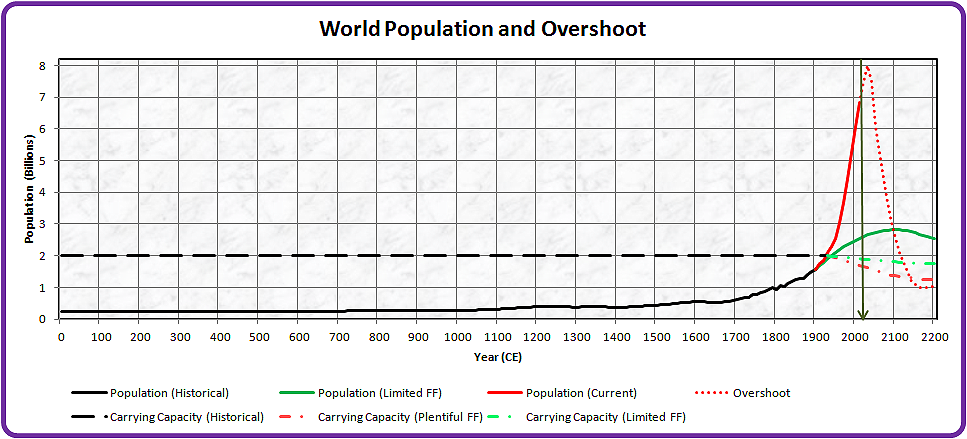
Modern techno-industrial humans are currently causing over a 1,000 fold increase in the rate of species extinctions on a pathway towards causing a 10,000 fold increase by the end of the 21st century.
The current anthropogenic mass extinction event could exceed that of the Permian, therefore humans exceeded carrying capacity, began causing species extinctions, long before modern times (1450-present). We started causing significant damage and species extinction about 3–4 thousand years ago with our empire-building ways.
From an objective view, not from a human centric view based on maximizing short-term self interest, we will need to contract the human footprint by two times two orders of magnitude if we are not to be a cancer on the earth. Gaia’s POV is objective. We are an invasive species. We will adapt, learn to live properly with the planet by listening to Nature, or be selected out of the ecos.
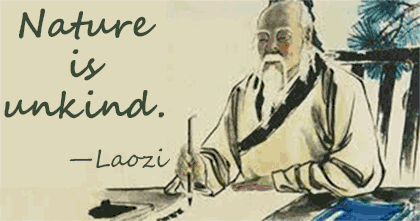
Comment: 8/13/2021
I was in high school in suburban Virginia when this topic, human population growth, was presented at school. The teacher talked about a man named Malthus and how a constant growth rate leads to exponential growth, and how the population can’t grow at a constant rate forever, and that is all true.
Then the teacher concluded that “fortunately”, the exponential growth of the population will naturally slow down and level off, forming what is called an S-shaped curve. Perhaps you were reassured when you were taught the same?
There is however nothing fortunate or reassuring about that S-shaped curve, because it happens for a very simple reason. The only way the population can stay a constant size is for the death rate to equal the birth rate.
We therefore have two choices. Either we can let famine, war, and other natural processes raise the death rate to match our current birth rate, or we can choose to intentionally lower the birth rate to match the current death rate. I know which choice I prefer, how about you?
Reply:
Professor Al Bartlett gave the same public lecture on Arithmetic, Population, and Energy: Sustainability 101 1,742 times, including to high schools, from 1969 until he died in 2013. He noted: "The greatest shortcoming of the human race is our inability to understand the exponential function." If he was not the teacher, likely the teacher you heard had heard Al’s lecture. Sustainability 101
Because exponential growth, at any rate however small, cannot continue, as limits are approached the rate of growth slows and may level out at a more or less steady-state, but only if carrying capacity was never exceeded. That growth will climax is a given. When is not possible to pinpoint as complex systems are not only more complex than we know, but more so than we can know. But that they will climax is a given.
Klaatu or some passing alien might view the coming climax as ‘fortunate’, but few humans who are not enlightened beings or systems ecologists will. We blew past carrying capacity long ago and are well into overshoot. Some humans who understand that growth cannot continue, e.g. those of the Transition Movement, plan to transition to a steady-state economy, resiliently of course, when the fabled Green New Deal is fully achieved. They have a tongue-tipped grasp of biophysical reality:
Producers may have to degrow a bit, but life for the consumers of green growth will live as good as or better than today and will grow qualitatively forever.
The less feel-good reality:
Dagnabbit! Sorry about that.
Basically, the few who would rather know than believe knew of our predicament and what the solution was in the 1970s. Catton summarized what was known in 1980 in his book, still worth reading, 'Overshoot: The Ecological Basis of Revolutionary Change'.
If in the early 1970s we had slammed on the brakes, we might have transitioned to a condition where degrowth would be gradual, involving no Malthusian die-off. But we didn’t. My vote, if I had one, would be for rapid managed degrowth in population and per capita consumption within the limits of just enough to avoid a significant (>5%) increase in individual mortality. In fewer words, strive for a rapid contraction of the global economy.
Rapid depopulation would involve a rapid birth-off to avoid a die-off. Initially one in two hundred women who wanted to procreate could, but in 50 years (i.e. ‘rapidly’) the average woman would need to have 2.1 children to maintain a population of prosperous humans living as K-strategists well under environmental carrying capacity as low intensity forager-farmers (mostly as a few might still be able to teach at the regional university except during harvest).
Nature is unkind. We will degrow our population or our population will degrow and while I’d suggest the former, I’m guessing the 99+% will demand that we keep on keeping on and so will be on the receiving end of the later.
The year of climax is uncertain. How fast the degrowth is unknown. That our population will never be less than zero is a given. What the nadir of our fortunes will be and when is unknown. If remnant populations persist, will they ‘recover’ and continue to repeat the pattern? Or will we come to understand and learn to live properly with the planet?
196. If the global population is actually increasing by about 1.5 percent per year, and growth rate persists, then in less than half a century the number of people who live on the planet will double?
To answer the actual question, if the global population of any species is increasing by a steady 1.5 percent per year, then the doubling time is about 70/rate or 69.3/1.5 or 46.2 years or a bit less than a half century.
Now I can talk science, no opinions, so everyone who would rather believe than know can surf on. Confirming one’s bias feels so much better.
The belief that fertility rates will continue to decline is a firmly held belief by many, but merely that. As Steven Pinker likes to point out, the steady reduction in scarcity over the last few centuries have favored the better angels of our nature. If you believe that as we become ever more enlightened (now), that the 21st century will be characterized by ever more abundance and lower poverty rates (per UN mandate), and less conflict, then fertility rates may continue to decline. Or not.
The ‘demographic transition’ is not a theory, just a phrase used to note that with increasing consumption (and pollution and complexity…), fertility rates in evermore complex modern techno-industrial societies decreases for some reason. Is it due to pollution (e.g. phthalates) causing ever reducing sperm count in males and loss of fertility in woman? Looks like this could become a significant driver, but isn’t yet.
Is declining fertility rates due to overdensity living over multiple generations, as happened to John B. Calhoun’s rats (and mice) of NIMH? Why would only humans not experience a ‘behavioral sink’ effect over 8–12 generations of living in urban abundance? Could increasing stress cause reduced fertility in humans as it does in other social species?
Or perhaps, with the glaring exception of Israel, educating and empowering women to serve industrial society by pursuing short-term self interests (as liberated wage-slaves to corporations, NGOs, governments, and businesses such as higher education) is the cause? I don’t know. And you don’t either.
I mentioned Israel, which is in the ‘news’ again, but that is a distraction. The news (information) the media will mostly ignore is that in areas of high religious conflict, regardless of how educated and empowered the ever so modern women are, futility rates remain high. Sometimes it takes religion.
In ultra-modern and empowered Jerusalem, Jewish women, with similar ‘rights’ and economic opportunities as Jewish women in the US and Britain and where birth control is readily available, Jewish women average 4.27 children each. The Jewish population in Jerusalem will double in (70/4.27) a bit over 16 years.
In Israel as a whole, Jewish women average 3.09 children each compared to 1.5 in the US and Britain. Women (who may self-identify as Palestinian) in relatively conflict-prone Gaza average 3.64 births (average age of population is 18 with over 5,000 people per sq-km—global average is 45 persons per sq km, India is over 320 persons per sq km, so doubling the population of Gaza in 19 years to 10,000 per sq km could affect the level of conflict, especially if resources such as food become scarce). In the more peaceful West Bank area the birth rate is 3.07 per woman, so it will take nearly 23 years to double the population.
As Yasser Arafat noted, when Palestinian women averaged 8 children (1960–65), 'The womb of the Arab woman is my strongest weapon’. In 37 years, the population of Israel as a whole will double if things keep on. From 1989 to present, the population had doubled, but the economy grew faster. If the economy doesn't more than double by 2058, expect more conflict. Perhaps the better angels of our nature will take a well deserved nap (just guessing, so ignore rhetorical offerings).
For peace in the world, we need to maintain at least the current 3.4 percent economic growth rate to double production and consumption in 20 years, as we have been. And then what? Do it again and again?
As we are now causing over a thousand fold increase in the rate of species extinction, we will be well on the path to causing a ten thousand fold increase by the end of this century as we will ‘need’ to keep growing the economy, doubling it every couple of decades to avoid scarcity induced conflict. All nations need to pass laws to prevent limits to growth. Sorry, just an opinion, ignore all primate prattle. Listen to Nature instead.

197. What is ecological literacy?
Ecological literacy is to be systems science literate or, as human ecologist and early systems thinker Garrett Hardin coined, to be ecolate. Ecolacy was in his view the third pillar of the educated mind, literacy and numeracy being the other two. Hardin did not formally define the term, so I took a shot at it:
Ecolate/Ecolacy 101: The endeavor to iterate towards understanding the dynamics of the world system through the macroscope of systems ecology to account for the complex interdependencies that underpin the natural environment and to consider the unintended consequences, short-term and long-term, of changing the system by asking, 'And then what?', so that we may have enough humans on the planet that really do understand it and can live with it properly [sustainably].
endeavor: 'Thought makes the whole dignity of man; therefore, endeavor to think well, that is the only morality.' — Blaise Pascal
iterate: 'You iterate towards the truth. You don’t know it....eventually we'll have a human on the planet that really does understand it and can live with it properly. That's the source of my optimism.' — James Lovelock
dynamics of the world system: 'The limits of Nature become also the limits of the system. The interplay between the limits of Nature and the trends and dynamics of the world system defines ultimately the historical tendencies of world system evolution.' — World System History: The Social Science of Long-term Change 2000.
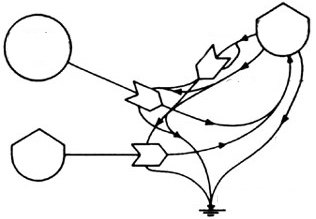 macroscope: 'Energy diagrams give the lenses for the macroscope through which we view the “3 Es”, energy, the environment, and economies.' — Mary Odum
macroscope: 'Energy diagrams give the lenses for the macroscope through which we view the “3 Es”, energy, the environment, and economies.' — Mary Odum
systems ecology: 'Systems ecology is the study of whole ecosystems and includes measurements of overall performance as well as a study of the details of systems design by which the overall behavior is produced from separate parts and mechanisms' — H.T. Odum 1994
complex interdependencies: 'Odum's emergy diagrams make visible the complex interdependencies of successful ecosystems.' — Architecture and Energy: Performance and Style 2013
unintended consequences: 'Every proposal to build a dam, to widen a highway, to cut down another forest, to turn wetlands into salable real estate, or to bury unwanted waste products is sure to have unintended consequences.... From now on, we must accept responsibility for all unintended consequences while doing our best to predict them in advance.' — Garrett Hardin
'And then what?': 'Of every well-meant proposal, ecologists ask a standard question: 'And then what?'... The proficiencies that education produces [fall] into three categories: literacy, numeracy, and ecolacy. The key question of the ecolate person is this: 'And then what?'... The three filters operate through these particular questions: Literacy: What are the words? Numeracy: What are the numbers? Ecolacy: And then what?' — Garrett Hardin
The three pillars of education are literacy, numeracy, and ecolacy [systems science literacy—a recognition of the centrality of energy principles], or the endeavor to love and understand language, number, and system over self. Some will embrace the quest to iterate towards being literate, numerate, and ecolate—to listen to Nature who has all the answers. Of the three, ecolacy alone is essential for the long-term survival of humans in Nature. The intelligentsia of modern techno-industrial society are partially science literate, commonly innumerate, and cluelessly unaware of being inecolate. It is quite possible to graduate from a top university with a 4.0 average and get a C- in Reality 101 and to devoutly live a life helping to rule the world (for a time) while consuming it as a kleptocrat.
198. What is one major world problem, and how do you think we should solve it?
Unfortunately I’ll have to interpret the question more than perhaps I should. That one problem needs to be picked is a given as is that it has a solution. So that excludes major global problems such as war/conflict or over/under population. I have no solution for conflict as conflict is a given—it cannot be wished or willed to go away.
South Korean women have on average less than one child and the government has spent $181 billion over the last decade to promote births, but their endeavors to increase birth rates significantly have failed. No country has a policy to reduce its population, so while the population of humans and livestock on the planet is one, perhaps the, major problem, no political systems can manage population, so I won’t pick population as a problem.

The inability to manage human or livestock populations, or slow the pace of planetary destruction (e.g. species extinction, increase in CO2), however, is itself a problem and solutions are to be considered. An inability to manage human demands on Nature’s resources is the major threat to the planetary life-support system we and all other species depend on.

So how to solve the problem? Start by endeavoring to understand the dynamics of the world system. Managing human demands implies having the foresight to know our limits and manage our behavior to not exceed them. So identify what prevents us from listening to Nature who has all the answers about what works to persist long-term on the planet (humans don’t get to determine this).
All organisms, for example, have to remain within the carrying capacity of environmental productivity to avoid overshoot and collapse, e.g. reindeer on St. Matthew Island. Our inability to understand that humans are not exceptions is based on our presumption of human supremacy, that we are different in kind from other animals. We cannot listen to Nature given that instead we only listen to one another and pick and choose what we like and dislike, are for or against.

If our being human centric isn’t working for us, as evidenced by the fine mess we are in, then the solution is to be nature centric, to recognize that we are not the center about which the universe spins. Nature is unkind and both can and will humble us. Our collective hubris is not working for us and will falter. We will stand down (or fall down).
Our sense of human supremacy will give way, and that we are subsystems of the biosphere will clarify our minds wonderfully. We will endeavor to understand and live properly with the planet. This is the viable solution, the one we must make so. The other solution is we fail and so will be selected out of the biosphere.
Will we figure out what to do? I don’t know.
199. What is our goal as humanity for the next 1,000 years?
The same as James Lovelock’s: "There have been seven [climate change] disasters since humans came on the earth, very similar to the one that's just about to happen. I think these events keep separating the wheat from the chaff. And eventually we'll have a human on the planet that really does understand it and can live with it properly. That's the source of my optimism." [ref]
Will we come to understand the planet (Gaia) and learn to live with it (her) properly as the millennia pass? I don’t know, but that is the only viable outcome. The other viable goal for life on Earth is we go extinct, likely within a thousand years. Nature alone determines what persists, what proper living is. We need to listen to Nature who has all the answers. Or in Ludwig Wittgenstein’s three words: “Understand or die.”
I AM MY WORLD.
Understand or die.
Don't think, but look!
Only describe, don't explain.
Language disguises thought.
Ethics and aesthetics are one.
What can be shown, cannot be said.
Hell isn't other people. Hell is yourself.
Nothing is so difficult as not deceiving oneself.
Not how the world is, but that it is, is the mystery.
An entire mythology is stored within our language.
Whereof one cannot speak, thereof one must be silent.
The limits of my language mean the limits of my world.
When we can't think for ourselves, we can always quote.
If a question can be put at all, then it can also be answered.
At the core of all well-founded belief lies belief that is unfounded.
There are no subjects in the world. A subject is a limitation of the world.
Just improve yourself; that is the only thing you can do to better the world.
What is the proof that I know something? Most certainly not my saying I know it.
If we spoke a different language, we would perceive a somewhat different world.
A tautology's truth is certain, a proposition's possible, a contradiction's impossible.
What is troubling us is the tendency to believe that the mind is like a little man within.
Philosophy is a battle against the bewitchment of our intelligence by means of language.
The philosopher is not a citizen of any community of ideas, that is what makes him a philosopher.
Never stay up on the barren heights of cleverness, but come down into the green valleys of silliness.
Don't for heaven's sake, be afraid of talking nonsense! But you must pay attention to your nonsense.
Most of the propositions and questions to be found in philosophical works are not false but nonsensical.
We are asleep. Our Life is a dream. But we wake up sometimes, just enough to know that we are dreaming.
The problems are solved, not by giving new information, but by arranging what we have known since long.
Nothing is more important for teaching us to understand the concepts we have than to construct fictitious ones.
If there were a verb meaning "to believe falsely," it would not have any significant first person, present indicative.
We feel that even if all possible scientific questions be answered, the problems of life have still not been touched at all.
If you and I are to live religious lives, it mustn't be that we talk a lot about religion, but that our manner of life is different.
If we take eternity to mean not infinite temporal duration but timelessness, then eternal life belongs to those who live in the present.
I should not like my writing to spare other people the trouble of thinking. But, if possible, to stimulate someone to thoughts of his own.
A man will be imprisoned in a room with a door that's unlocked and
opens inwards; as long as it does not occur to him to pull rather than push.
For a large class of cases ― though not for all ― in which we employ the word
meaning it can be defined thus: the meaning of a word is its use in the language.
The great delusion of modernity, is that the laws of nature explain the universe for us. The
laws of nature describe the universe, they describe the regularities. But they explain nothing.
People nowadays think that scientists exist to instruct them, poets, musicians, etc. to give
them pleasure. The idea that these have something to teach them - that does not occur to them.
The truly apocalyptic view of the world is that things do not repeat themselves. It isn’t absurd, e.g., to believe
that the age of science and technology is the beginning of the end for humanity; that the idea of great progress is
delusion, along with the idea that the truth will ultimately be known; that there is nothing good or desirable about
scientific knowledge and that mankind, in seeking it, is falling into a trap. It is by no means obvious that this is not how things are.
― Ludwig Wittgenstein, 1889-1951 [ref]
200. To save the planet should we all stop shopping?
The Guardian article cited is of interest: Overconsumption and the environment: should we all stop shopping? by Jamie Waters reviewing a book by J.B. MacKinnon titled The Day the World Stops Shopping: How ending consumerism gives us a better life and a greener world.
https://www.theguardian.com/lifeandstyle/2021/may/30/should-we-all-stop-shopping-how-to-end-overconsumptionFirst, as always, vet sources. Waters is a freelance writer specializing in business, finance and fashion in the UK. He interviews another freelance writer from Canada, J.B. MacKinnon, best known for co-authoring the bestselling book The 100-Mile Diet: A Year of Local Eating, read by environmentally aware Transition Movement types, typically upper-middle class professionals with interests in solar panels and gardening in ecovillages of the like-minded. J. B. MacKinnon - Wikipedia
Freelance writers are part of and products of the monetary culture. They create readable content for people to consume. My wife is an enthusiastic consumer of the performance art of Reverend Billy and his Church of Stop Shopping. She bought one of his books. She, as would many of his devout followers, would happily sing in his Stop Shopping Choir about the imminent "Shopocalypse", which assumes the end of humanity will come about through manic consumerism. But do consumers of Billy’s fervor actually shop less?
https://en.wikipedia.org/wiki/Reverend_Billy_and_the_Church_of_Stop_ShoppingAn inquiring graduate student may want to know if Reverend Billy fans actually shop less and do a study, but I’m guessing Reverend Billy profits from entertaining shoppers. Members of ecovillages with solar panels to power their Tesla may think nothing of flying to Bhutan for a eco-vacation. Those who carry stainless steel straws in bamboo cases tend to be above average consumers per studies I recall, likely could cite, but I won’t.
Should we all stop shopping? Skip the title and focus on MacKinnon’s subtitle: “How ending consumerism gives us a better life and a greener world”. Given the premise that while not shopping at all would be best, reducing shopping/consuming stuff 25 percent would be doable and result in a better life (if not best) for consumers (and the planet too), one that is as good or better, then not shopping would improve the tiresome life of the bedraggled consumer.
“When what you’ve known throughout your lifetime is what satisfaction you can draw from a consumeristic materialistic society, it’s very hard to imagine there’s an alternative that’s going to work as well or better.” MacKinnon, of course, assures us: “But there is.” This is classic overselling without, as usual, any hint of irony.
The ideas trafficked in appeal to the guilty feeling who want solutions. To understand the set and setting, consider the message being trafficked in that overpopulation isn’t a problem, that the planet is in the ICU facing multiple systems failures because some people in modern techno-industrial society are consuming too much. To think otherwise, of course, is to be a racist who wants to kill black babies.
So, my answer (as if it mattered)? YES! we should all stop shopping to collapse the monetary culture ASAP. If I (or you) stop buying stuff and services, then demand will be slightly reduced, lowering prices, increasing the consumption of others. That’s why we ALL have to stop. But we won’t, so we cannot change the trajectory of modern techno-industrial society by abandoning it like rats on a sinking ship. Going down with the ship, however magnificent its passengers once thought it to be, may not work out either. Maybe we should abandon it, but not like rats on a sinking ship.
We who foresee the outcome of our empire’s trajectory (collapse of complex society as usual) should stop shopping, stop living to make money and spend it like rats pushing levers in a Skinner box, because doing so may have a viable outcome. Abandoning the ship of state, whichever one you happen to be enmeshed in, is to consider because doing so could help posterity come to live viable lives that persist long-term on the planet as the millennia go by, i.e. live without destroying the planetary life-support system all life depends on.
In short, posterity could live a better life on a greener planet, but those consumers transitioning to it will not. If they mandate/expect that they must live as well or better, then we will keep on keeping on breeding and consuming and burning fossil fuels to make food and solar PV and wind turbans for a time until we can’t.
We will continue to ignore the warnings of Nature and those who endeavor to listen to Nature. We will continue to deny and obfuscate, even if we know that the outcome is the mass extinction event currently underway that could rival that of the Permian will remorselessly involve a great die-off of posterity too.

Maybe some humans could come to understand the planet and learn to live on it properly as members in good standing who work not for their short-term self interest as Anthropocene enthusiasts (for a time), but as “our biosphere’s handmaiden anew”.
———————————-
“What is the general answer? Eject economic expansionism, stop growth, use available energies for cultural conversion to steady state, seek out the condition now that will come anyway, but by our service be our biosphere's handmaiden anew.” —Howard T. Odum, Energy, Ecology, & Economics, 1973
“There have been seven [climate change] disasters since humans came on the earth, very similar to the one that's just about to happen. I think these events keep separating the wheat from the chaff. And eventually we'll have a human on the planet that really does understand it and can live with it properly. That's the source of my optimism.” —James Lovelock, Enjoy Life While You Can

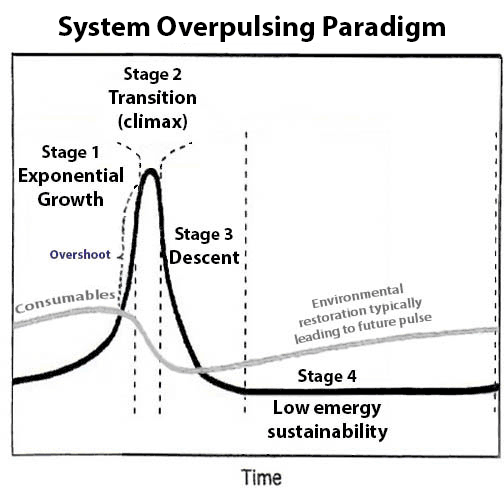
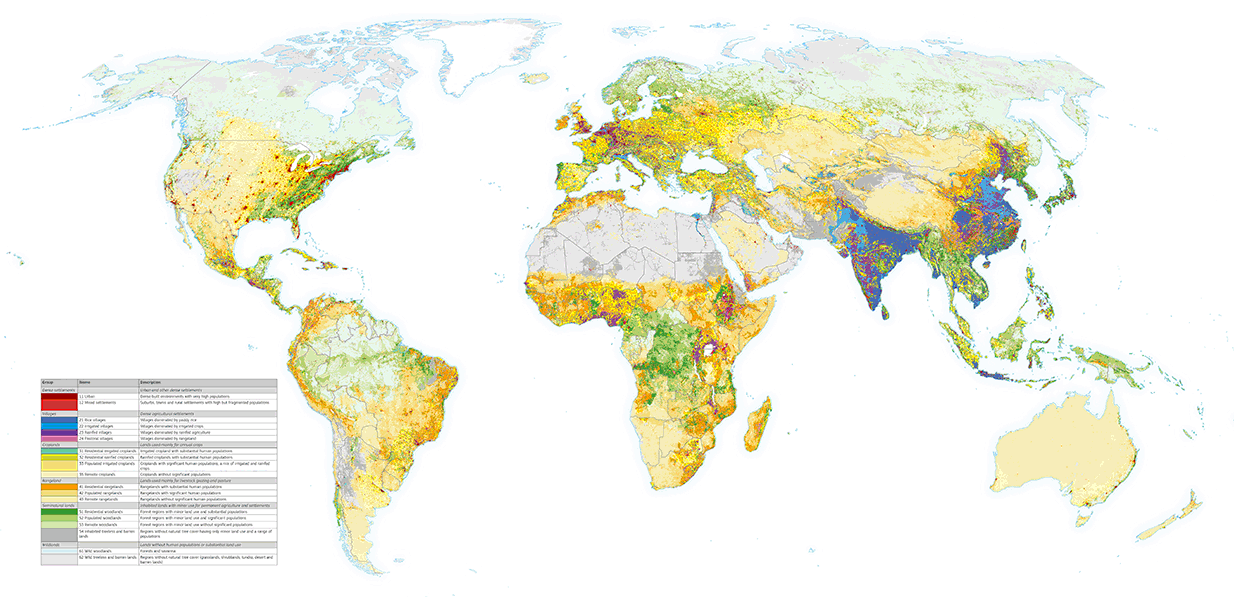 Humans: 80% and increasing.
Humans: 80% and increasing.